Hieronder hebben we een lijst van meer dan 100 kippenrassen samengesteld.
Voor elk ras beschrijven we hun temperament en legvermogen, zodat u uw perfecte kip kunt vinden.
We hebben zelfs een tool gemaakt om u te helpen uw perfecte kip te vinden.
Of u nu op zoek bent naar een prachtige legpluim, een prachtige tentoonstellingsvogel of een huisdier, dit artikel zou iets voor u moeten hebben.
Verschillende van onze selecties worden ernstig bedreigd en hebben hulp nodig bij het behoud (misschien vindt u iets dat u zou willen helpen behouden).
Wat uw motivatie ook is om dit te lezen, we hopen dat u het nuttig en interessant zult vinden...
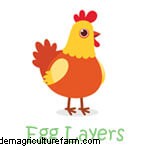
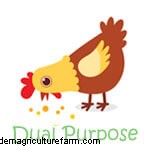
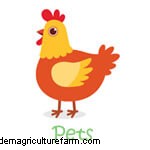
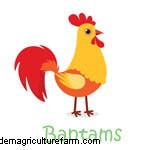
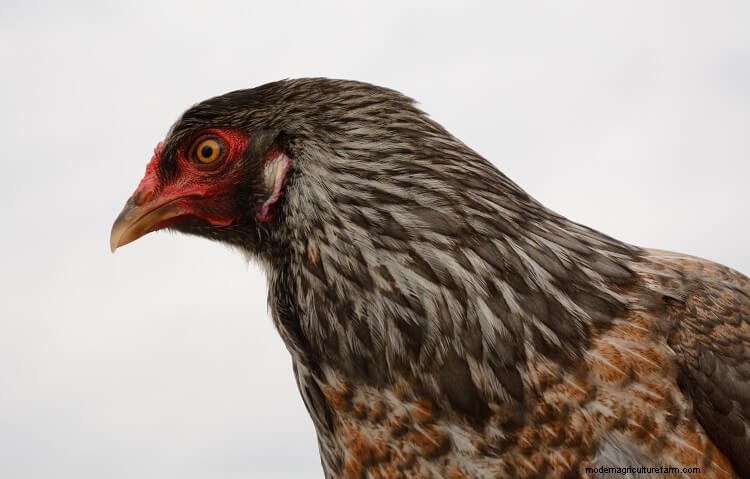
Ameraucana's worden gekweekt uit de Araucana en zijn een lust voor het oog.
Hun verenkleed is veelkleurig en ze hebben ook baarden en moffen waardoor ze een ongewoon pluizig uiterlijk hebben.
Volgroeide hennen wegen ongeveer 5 pond of zo, maar als je kleiner wilt, zijn ze ook verkrijgbaar in krielmaat. Hun belangrijkste claim op roem is het leggen van blauwe eieren . Het zijn behoorlijke leghennen die 3-4 eieren per week produceren.
Wat hun persoonlijkheid betreft, ze zijn vriendelijk, intelligent, nieuwsgierig en kunnen goed met kinderen overweg.
Ze zijn stil genoeg om ook in een stedelijke omgeving te houden.
| Ameraucana |
|---|
| Hoofdgebruik: Eieren |
| Jaarlijkse eierproductie: 175-250 |
| Eierkleur: Blauw |
| Vriendelijk voor beginners: Ja |
| Temperament: Vriendelijk |
| Geluidsniveau: Normaal |
| Voorkeursklimaat: Elke |
Dit ras is ontstaan in Italië en heeft de klassieke vorm van een mediterraan ras.
Ze heeft een prachtig zwart-wit gevlekt verenkleed dat mooier wordt naarmate ze ouder wordt.
Het is een winterharde kip die de hele winter kan leggen en 4-5 grote witte eieren per week produceert.
Bij dit ras mag je een actieve duivin verwachten die opsluiting niet goed verdraagt. Ze zijn vriendelijk tegen hun mensen en kunnen erg spraakzaam zijn.
Het is een vroegrijpe legheester met een goede voederconversie.
Standaard maten wegen ongeveer 6 pond, maar ze zijn ook verkrijgbaar in krielmaat.
| Ancona |
|---|
| Hoofdgebruik: Eieren |
| Jaarlijkse eierproductie: 175-250 |
| Eierkleur: Wit |
| Vriendelijk voor beginners: Ja |
| Temperament: Schichtig |
| Geluidsniveau: Normaal |
| Voorkeursklimaat: Elke |
De Andalusiër is een ander mediterraan ras.
Hun exacte oorsprong is onbekend, maar we weten wel dat ze vrij oud zijn omdat ze door de Romeinen werden bewaard.
Het best te omschrijven als waardig en evenwichtig, ze zijn ook vriendelijk en nieuwsgierig . Ze gedijen buiten goed, omdat een nauwe opsluiting ze vluchtig, nerveus en neurotisch maakt.
Je vindt dit ras meestal in het blauw. In feite houden veel mensen Andalusiërs voor hun onvolledige dominante blauwe gen en gebruiken het om te opwaarderen de blauwe veren in andere rassen. Eenmaal volgroeid zal ze ongeveer 5 pond wegen (er zijn krielvariëteiten beschikbaar).
De hennen zijn een redelijk goede laag grote witte eieren (ongeveer drie eieren per week).
| Andalusisch |
|---|
| Hoofdgebruik: Eieren |
| Jaarlijkse eierproductie: 100-170 |
| Eierkleur: Wit |
| Vriendelijk voor beginners: Nee |
| Temperament: Vriendelijk |
| Geluidsniveau: Luid |
| Voorkeursklimaat: Warme klimaten |
Maak kennis met de Appenzeller Spitzhauben.
Ze is de nationale vogel van Zwitserland en zoals je misschien wel raadt, zijn ze erg winterhard!
De Appenzeller is een kleine, actieve kip die uitstekend kan foerageren.
Deze duivinnen hebben een zeer zelfstandig karakter en zijn intelligent en altijd alert. Ze kunnen erg luidruchtig zijn, dus het leven in de stad zou niet bij hen passen.
De kleurvarianten zilver, goud en gemzen zijn het populairst, maar deze hen blijft zeldzaam in de VS.
Verwacht dat ze ongeveer drie middelgrote witte eieren per week leggen.
| Appenzeller |
|---|
| Hoofdgebruik: Eieren |
| Jaarlijkse eierproductie: 100-170 |
| Eierkleur: Wit |
| Vriendelijk voor beginners: Nee |
| Temperament: Vriendelijk |
| Geluidsniveau: Luid |
| Voorkeursklimaat: Elke |
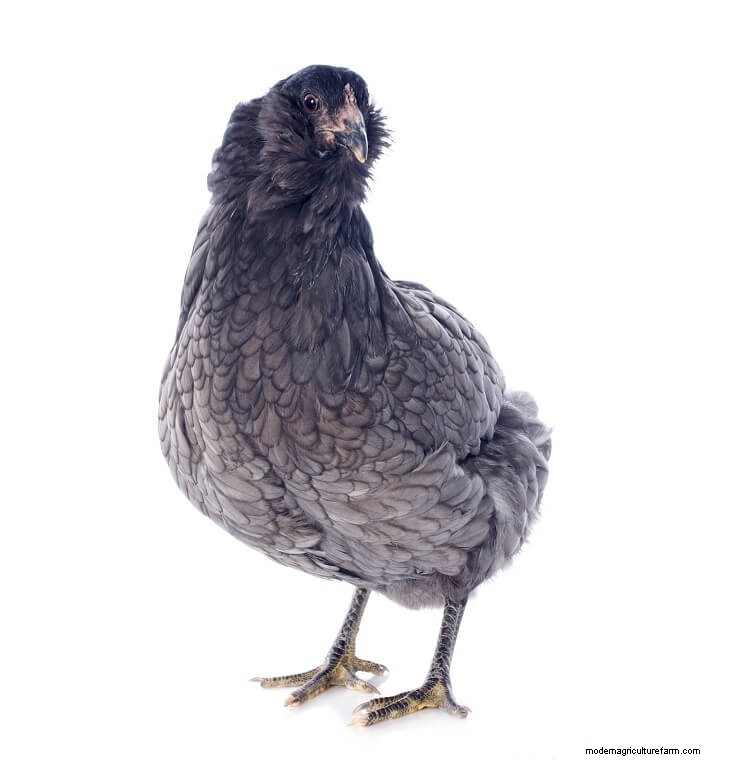
Oorspronkelijk uit Chili, werd dit ras gevonden tussen de Mapuche-indianen.
Men denkt dat ze een mix is van twee oudere rassen (de Collonca en Quetros).
De Araucana ziet er absoluut anders uit. Ze heeft geen achterwerk en heeft rare plukjes die uit hun oren steken. Deze plukjes zien er nogal grillig uit, maar het gen dat deze plukjes maakt, kan dodelijk zijn voor de kuikens. Ongeveer 25% van alle Araucana-kuikens sterft in de schaal vanwege het tuft-gen.
Araucana's zijn het best te omschrijven als vriendelijk, rustig en goed met kinderen. Ze zijn liever actief, maar tolereren opsluiting.
Het zijn behoorlijke lagen van drie middelgrote lichtblauwe eieren per week.
Ze is de originele blauwe eierlegger.
Hennen hebben de neiging om broeds te worden en goede moeders te zijn.
Ze zijn een kleine vogel met een gewicht van ongeveer 4-5 pond voor de standaard hen. Hoewel er krielen bestaan, zijn ze moeilijk te vinden.
| Araucana |
|---|
| Hoofdgebruik: Eieren |
| Jaarlijkse eierproductie: 100-170 |
| Eierkleur: Blauw |
| Vriendelijk voor beginners: Ja |
| Temperament: Vriendelijk |
| Geluidsniveau: Rustig |
| Voorkeursklimaat: Elke |
De Austra White is een superster die eieren legt.
Ze is gefokt voor de eiproductie en zal elke week 4+ grote eieren leggen.
Hun ouders zijn een zwarte Australorp haan met een witte Leghorn hen.
Het Australorp-gen voegt wat grootte toe aan de normaal slanke Leghorn. Hennen kunnen mooi mollig worden tot ongeveer 5 pond en hanen tot ongeveer 6 pond.
Ze worden beschreven als kalm, volgzaam en vriendelijk, dus ze doen het goed met kinderen en hebben er geen bezwaar tegen om opgepakt te worden.
Hun verenkleed is meestal wit met af en toe zwarte vlekken.
| Austra Wit |
|---|
| Hoofdgebruik: Eieren |
| Jaarlijkse eierproductie: 250+ |
| Eierkleur: Wit |
| Vriendelijk voor beginners: Ja |
| Temperament: Volgzaam |
| Geluidsniveau: Normaal |
| Voorkeursklimaat: Elke |
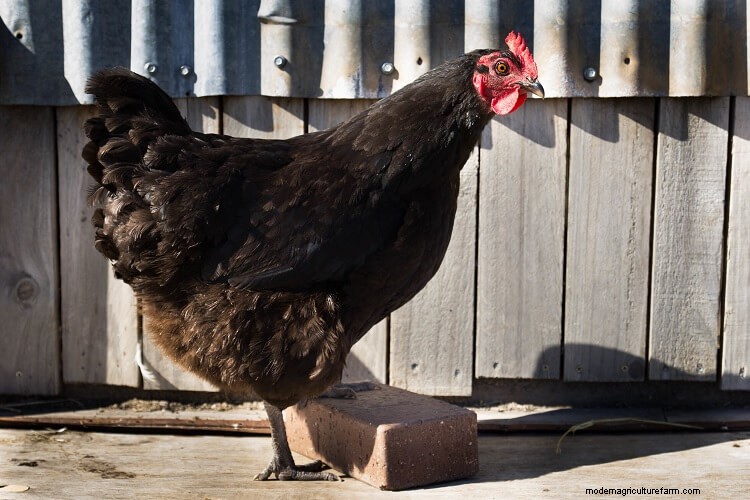
De Australorp is ontstaan in Australië door Orpingtons te kruisen met Rhode Island Reds, Minorcas en een paar andere rassen.
Dit zorgde voor een eierleggende superster en Australorps zijn de nationale vogel van Australië.
Hennen leggen elke week 4-5 lichtbruine middelgrote eieren, gemiddeld ongeveer 250 eieren per jaar.
Hoewel ze aanvankelijk verlegen zullen zijn, zal ze nieuwsgierig worden en graag dingen onderzoeken.
Meestal is hun verenkleed zwart, maar er zijn ook andere variëteiten beschikbaar.
Het is een onderhoudsarme kip die het goed doet met zowel kinderen als beginners.
| Australorp |
|---|
| Hoofdgebruik: Eieren |
| Jaarlijkse eierproductie: 250+ |
| Eierkleur: Bruin |
| Vriendelijk voor beginners: Ja |
| Temperament: Vriendelijk |
| Geluidsniveau: Normaal |
| Voorkeursklimaat: Elke |
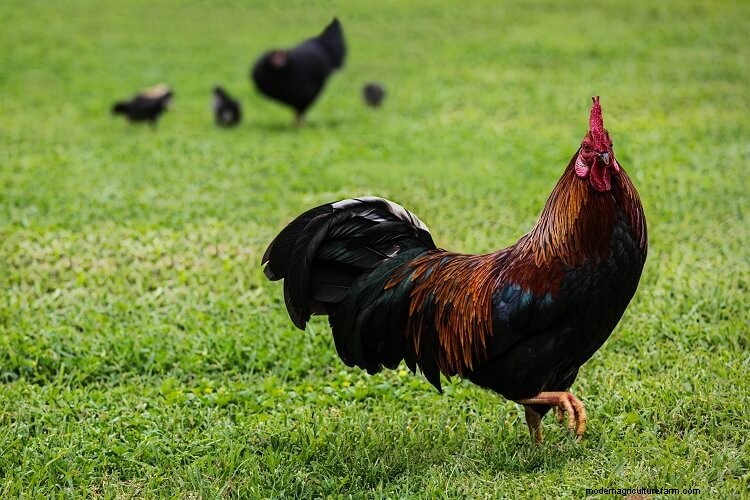
Black Copper Marans zijn enorm populair geworden vanwege hun donkere chocoladekleurige eieren.
Naarmate het legseizoen vordert, zal de kleur van de eieren lichter worden, maar het zal nog steeds behoorlijk donker zijn.
De Marans zijn een combinatie van verschillende rassen die in het begin van de twintigste eeuw in West-Frankrijk werden samengebracht. Hun verenkleed is opvallend zwart (met groene irisatie) met koperkleurige hackles.
Ze worden beschouwd als een dubbeldoelras en leggen ongeveer 3 eieren per week.
Ze is een rustige en zachtaardige duivin die over het algemeen redelijk taai en gezond is. Er zijn zowel standaardmaten (hennen rond de 6.5lb) als krielen. Maar krielen zijn ongelooflijk zeldzaam en moeilijk te vinden.
| Zwart Koper Marans |
|---|
| Hoofdgebruik: Eieren |
| Jaarlijkse eierproductie: 100-170 |
| Eierkleur: Chocolade |
| Vriendelijk voor beginners: Ja |
| Temperament: Volgzaam |
| Geluidsniveau: Rustig |
| Voorkeursklimaat: Elke |
Ook bekend als een Black Star, is de black sex link-kip een van de meest populaire kippen die er zijn.
Ze zijn technisch gezien geen ras, maar een hybride. Ze zijn een kruising tussen een Rhode Island Red of New Hampshire haan met een Barred Rock hen. Als de kuikens uitkomen, hebben de mannetjes een witte stip op hun kop (ze zijn dus heel gemakkelijk te seksen).
Ze zijn populair omdat het geweldige eierlagen zijn van 5 lichtbruine eieren per week.
Ze is een volgzaam, vriendelijk en actief ras dat gehecht zal raken aan hun verzorgers.
| Zwarte sekslink |
|---|
| Hoofdgebruik: Eieren |
| Jaarlijkse eierproductie: 250+ |
| Eierkleur: Bruin |
| Vriendelijk voor beginners: Ja |
| Temperament: Volgzaam |
| Geluidsniveau: Normaal |
| Voorkeursklimaat: Elke |
De bruine Leghorn is een van de Leghornsoorten die het goed doet op een hoeve.
Dit is een actieve, zelfstandige en intelligente kip die goed kan vliegen.
Ze staan vooral bekend als vindingrijke verzamelaars die goedkoop te houden zijn.
Brown Leghorns geeft je elke week 3-4 grote witte eieren. Ze hebben niet de neiging om broeds te worden, maar zijn wel goede moeders.
Oorspronkelijk uit Italië hebben ze de slanke mediterrane bouw. Ze kunnen een enkele of roze kam hebben en kunnen ook witte oorlellen hebben.
Helaas moeten ze het stadsleven vermijden, omdat ze luidruchtig kunnen zijn.
| Bruine Leghorn |
|---|
| Hoofdgebruik: Eieren |
| Jaarlijkse eierproductie: 175-250 |
| Eierkleur: Wit |
| Vriendelijk voor beginners: Ja |
| Temperament: Vet (Zelfverzekerd) |
| Geluidsniveau: Luid |
| Voorkeursklimaat: Warme klimaten |
De Kempen is een oud nobel ras uit België.
Er wordt aangenomen dat het al in de Romeinse tijd bestond, maar sindsdien zijn ze in populariteit afgenomen en worden ze nu als ernstig bedreigd beschouwd.
Ze is een kleine hen en weegt slechts ongeveer 5 pond (krielvariëteiten zijn ook beschikbaar). Er zijn twee varianten:zilver en goud.
Campines produceert 3 grote witte eieren per week.
Ze staan bekend als een actief ras dat dol is op foerageren. Ze is nieuwsgierig, intelligent en vriendelijk tot op zekere hoogte, maar houdt er niet van om vastgehouden te worden. Ze zijn tolerant voor een breed scala aan klimaten, maar doen het niet goed in erg koude gebieden.
| Campine |
|---|
| Hoofdgebruik: Eieren |
| Jaarlijkse eierproductie: 175-250 |
| Eierkleur: Wit |
| Vriendelijk voor beginners: Nee |
| Temperament: Vet (Zelfverzekerd) |
| Geluidsniveau: Normaal |
| Voorkeursklimaat: Elke |
Ondanks de naam legt de Cherry Egger geen kersenkleurige eieren!
De naam verwijst naar de kleur van hun verenkleed.
Ze zijn een hybride waarvan de ene ouder de Rhode Island Red is en de andere een New Hampshire Red.
Zoals je zou verwachten van zulke vruchtbare eierleggende ouders, het zijn ook geweldige leghennen die elke week 4-5 eieren geven.
Ze is een vriendelijk en volgzaam ras dat geschikt is voor een stedelijke omgeving.
Ze zijn gemakkelijk verkrijgbaar bij veel broederijen.
| Cherry Egger |
|---|
| Hoofdgebruik: Eieren |
| Jaarlijkse eierproductie: 250+ |
| Eierkleur: Bruin |
| Vriendelijk voor beginners: Ja |
| Temperament: Vriendelijk |
| Geluidsniveau: Normaal |
| Voorkeursklimaat: Elke |
The Cinnamon Queen is nog een andere naam voor Red Sex Link Chickens.
Red Sex Links zijn zo genoemd omdat je het verschil tussen het mannetje en het vrouwtje kunt zien bij het uitkomen (dus er mogen geen toevallige hanen zijn)!
Het is een hybride kip die zeer goed presteert bij het leggen van eieren. Ze zou elke week ongeveer 5-6 eieren moeten leggen.
U kunt een vriendelijk, volgzaam ras verwachten dat gemakkelijk te hanteren is.
Ze staan bekend als stil, dus een stedelijke omgeving is oké voor hen.
| Kaneelkoningin |
|---|
| Hoofdgebruik: Eieren |
| Jaarlijkse eierproductie: 250+ |
| Eierkleur: Bruin |
| Vriendelijk voor beginners: Ja |
| Temperament: Volgzaam |
| Geluidsniveau: Rustig |
| Voorkeursklimaat: Elke |
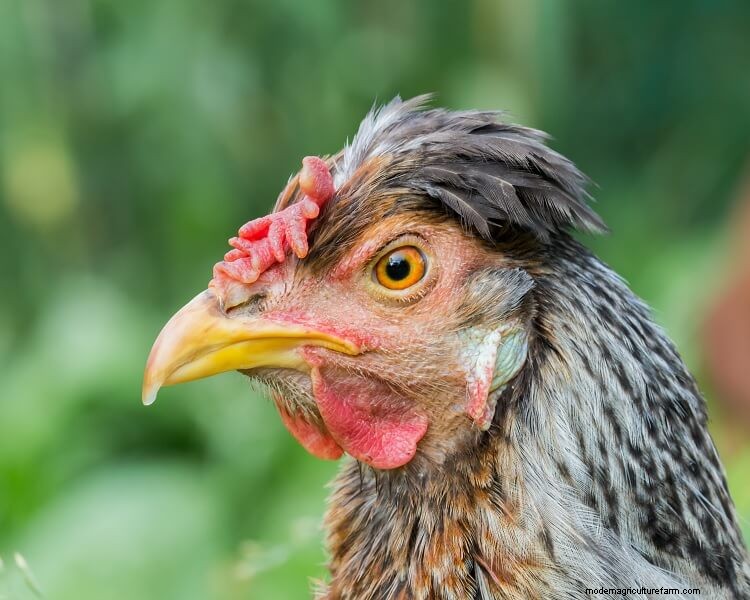
De Cream Legbar werd in de jaren dertig in het Verenigd Koninkrijk gecreëerd door professor Punnett. Hij probeerde een vogel te maken die blauwe eieren legde en ook autosexing had.
Hij slaagde met de Legbar.
De kuikens kunnen gesekst worden bij het uitkomen, dus er mogen geen toevallige hanen in het stel worden gevonden. Ze zijn een goede eierlaag en geven elke week 3-4 middelgrote lichtblauwe eieren.
Blauwe eieren komen van de Araucana-afstamming.
Hun andere genetische samenstelling komt van de Leghorn en Barred Rock.
Over het algemeen is het een vriendelijk en volgzaam ras dat gemakkelijk te hanteren is.
| Crème Legbar |
|---|
| Hoofdgebruik: Eieren |
| Jaarlijkse eierproductie: 175-250 |
| Eierkleur: Blauw |
| Vriendelijk voor beginners: Ja |
| Temperament: Vriendelijk |
| Geluidsniveau: Normaal |
| Voorkeursklimaat: Elke |
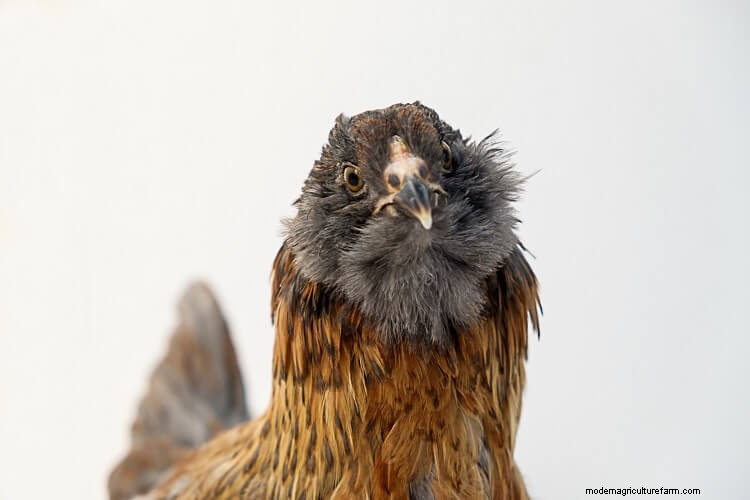
De Easter Egger is een vrolijke en vrolijke kip.
Ze zijn vooral bekend als een vriendelijk ras dat geweldig is met kinderen en ook van rondetijden houdt.
Hoewel dit ras technisch gezien een hybride is, zijn ze zeer gewild vanwege hun gekleurde eieren.
Ze kunnen blauwe, olijfkleurige, groene en zelfs roze gekleurde eieren leggen . Welke kleur je kip ook legt, het is de enige kleur die ze legt - het zijn geen individuele regenboogmakers!
Ze verdraagt een breed scala aan temperaturen en klimaten en is over het algemeen onderhoudsarm.
| Easter Egger |
|---|
| Hoofdgebruik: Eieren |
| Jaarlijkse eierproductie: 175-250 |
| Eierkleur: Regenboog (Overig) |
| Vriendelijk voor beginners: Ja |
| Temperament: Volgzaam |
| Geluidsniveau: Rustig |
| Voorkeursklimaat: Elke |
De Golden Comet is een andere hybride Red Sex Link Chicken.
Ze werd alleen gebruikt voor de pluimvee-industrie, maar deze lieve dame is een favoriet in de achtertuin geworden.
Dit ras heeft een rustige, kalme en zachte persoonlijkheid. Ze houden van hun mensen en kinderen, evenals van hun rondetijd.
Het zijn supersterren die eieren leggen 5-6 eieren per week geven. Helaas hebben ze, omdat ze zijn gefokt om eieren te leggen, meestal een korte levensduur (minder dan 5 jaar).
Ze is een winterharde kleine hen en verdraagt zowel warme als koude klimaten. Ze houden ervan om vrij rond te scharrelen, maar tolereren opsluiting met voldoende ruimte.
| Gouden Komeet |
|---|
| Hoofdgebruik: Eieren |
| Jaarlijkse eierproductie: 250+ |
| Eierkleur: Bruin |
| Vriendelijk voor beginners: Ja |
| Temperament: Volgzaam |
| Geluidsniveau: Normaal |
| Voorkeursklimaat: Elke |
De Hamburgse kip is terug te voeren tot het Holland van de veertiende eeuw, waar ze vermoedelijk zijn ontstaan. Ze worden soms Moonies genoemd vanwege hun verenkleed.
Het is een klein ras, met kippen die slechts 4 pond wegen.
Het ras is vrij moeilijk te vinden en staat op de lijst van Livestock Conservancy.
Haar persoonlijkheid is actief en enigszins vluchtig - ze zijn erg handig met roofdieren en vliegen goed.
| Hamburg |
|---|
| Hoofdgebruik: Eieren |
| Jaarlijkse eierproductie: 175-250 |
| Eierkleur: Wit |
| Vriendelijk voor beginners: Nee |
| Temperament: Schichtig |
| Geluidsniveau: Normaal |
| Voorkeursklimaat: Elke |
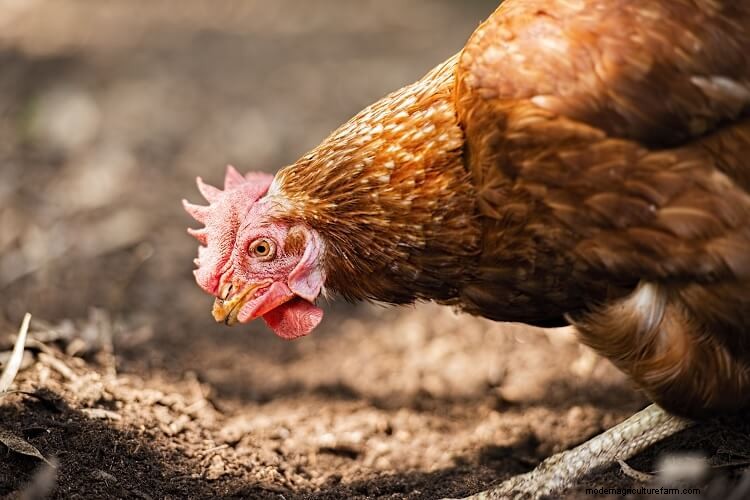
De ISA Brown is gefokt uit het Institut de Selection Animale.
Ze staan ook bekend als een Hubbard ISA en hun exacte genetische samenstelling is een goed bewaard geheim en werd in 1978 gepatenteerd.
ISA Browns werden gefokt als eierlegmachines voor de pluimvee-industrie en ze zullen de eerste 18 maanden ongeveer 5-6 grote bruine eieren per week leggen, daarna zal de productie een beetje teruglopen.
Helaas hebben ze een zeer korte levensduur van 2-3 jaar - al dat leggen van eieren is zwaar voor hun lichaam.
Het zijn aanhankelijke duivinnen en hebben vaak een speciale band met hun mensen met veel rondetijden en knuffels.
| ISA Bruin |
|---|
| Hoofdgebruik: Eieren |
| Jaarlijkse eierproductie: 250+ |
| Eierkleur: Bruin |
| Vriendelijk voor beginners: Ja |
| Temperament: Volgzaam |
| Geluidsniveau: Normaal |
| Voorkeursklimaat: Elke |
De Isbar is in de jaren vijftig door een katholieke priester gemaakt en is een relatief nieuw ras. Daardoor zijn ze nog niet toegelaten tot de American Poultry Association.
Ze zijn klein met kippen met een gewicht van 3-3,5 pond. Ze kunnen worden gebruikt als kip voor twee doeleinden, maar worden vaker gehouden voor hun eieren.
Verwacht een intelligente, rustige en gemakkelijke duivin die vriendelijk is voor hun mensen.
Kippen leggen elke week 3-4 groene eieren - de diepte van het groen kan variëren van licht salie tot mosgroen.
Omdat ze in Zweden zijn gemaakt, zijn ze behoorlijk koudtolerant met prachtige dichte bevedering.
Het zijn goede verzamelaars en geven de voorkeur aan scharrelen boven opsluiting.
Interessant is dat ze ook autosexing zijn, wat betekent dat kuikens kunnen worden gesekst bij het uitkomen.
| Isbar |
|---|
| Hoofdgebruik: Eieren |
| Jaarlijkse eierproductie: 175-250 |
| Eierkleur: Regenboog (Overig) |
| Vriendelijk voor beginners: Ja |
| Temperament: Volgzaam |
| Geluidsniveau: Normaal |
| Voorkeursklimaat: Winterhard |
De Jaerhon is het enige kippenras dat uit Noorwegen komt .
Het werd in de jaren 1920 ontwikkeld uit de Landrace-vogels van Noorwegen (die nu allemaal zijn uitgestorven).
Het zijn kleine maar vruchtbare lagen witte eieren. De duivinnen staan niet bekend om hun broedsheid, dus hun moederschap is onbekend.
Ze houden ervan om vrij rond te scharrelen en zijn zeer roofdierbewust. Ze zijn actief, houden van zwerven en vliegen heel goed. Dit ras is vriendelijk tegenover hun geleiders en is ook stil.
De Jaerhon is er in twee kleurvarianten:licht en donker. Verrassend genoeg is er ook een krielsoort.
| Jaerhon |
|---|
| Hoofdgebruik: Eieren |
| Jaarlijkse eierproductie: 250+ |
| Eierkleur: Wit |
| Vriendelijk voor beginners: Ja |
| Temperament: Vriendelijk |
| Geluidsniveau: Rustig |
| Voorkeursklimaat: Winterhard |
De Langshan verscheen voor het eerst in Engeland aan het einde van de 19e eeuw toen hij uit China werd geïmporteerd.
Het is een grote kip voor twee doeleinden met een zeer rechtopstaande koets. Ze zijn actief en geven er de voorkeur aan om zich te verspreiden, maar ze kunnen goed genoeg opgesloten worden.
Interessant is dat zij de enige kip zijn waarvan bekend is dat ze een pruimkleurig ei legt.
De hennen wegen ongeveer 6,5 pond en zijn goede leghennen die 3 grote eieren per week leggen.
Over het algemeen zijn ze kalm, volgzaam en vriendelijk voor hun mensen.
| Langshan |
|---|
| Hoofdgebruik: Eieren |
| Jaarlijkse eierproductie: 100-170 |
| Eierkleur: Regenboog (Overig) |
| Vriendelijk voor beginners: Ja |
| Temperament: Volgzaam |
| Geluidsniveau: Normaal |
| Voorkeursklimaat: Elke |
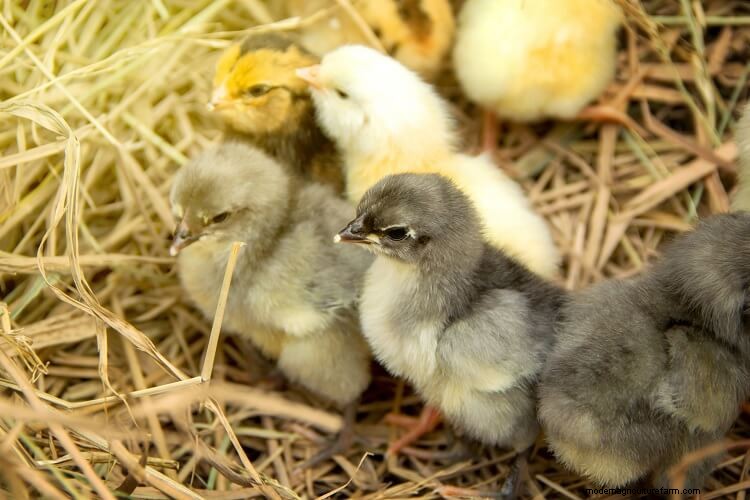
Olive Eggers is technisch gezien een hybride en is een vrij nieuwe introductie in de kippenscene.
Ze zijn het resultaat van het kruisen van een donkerbruine eierlaag met een blauwe eierlaag (bijvoorbeeld een Ameraucana hen met een Welsumer haan).
Hun uiterlijk kan variëren, maar de kippen leggen een olijfkleurig ei.
Ze kunnen voor twee doeleinden worden gebruikt (hennen wegen ongeveer 5-6 pond), maar ze worden meestal meer voor eieren gehouden. Ze zijn winterhard en houden van foerageren, hoewel ze opsluiting heel goed verdragen.
Dit is een vriendelijke en volgzame kip die het goed doet met kinderen.
| Olive Egger |
|---|
| Hoofdgebruik: Eieren |
| Jaarlijkse eierproductie: 100-170 |
| Eierkleur: Regenboog (Overig) |
| Vriendelijk voor beginners: Ja |
| Temperament: Volgzaam |
| Geluidsniveau: Normaal |
| Voorkeursklimaat: Elke |
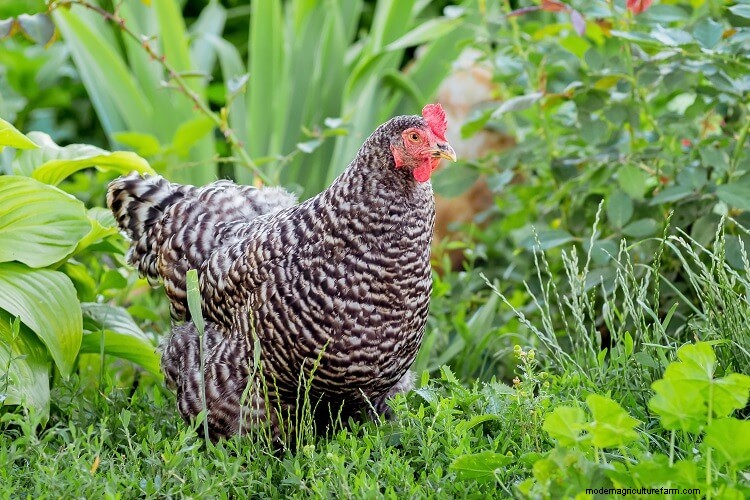
De Plymouth Rock is tegenwoordig een van de meest betrouwbare rassen. Ze gaat al sterk sinds de jaren 1800 en is vandaag de dag nog steeds erg populair.
Dit ras is niet zo snel volwassen als de industriële kippen van tegenwoordig, maar ze zijn het wachten meer dan waard!
Hennen komen binnen op 7 pond en zullen een constante 4-5 lichtbruine eieren leggen.
Ze zijn ook een autosexing ras, wat betekent dat je de jongens van de meisjes kunt onderscheiden zodra ze uitkomen.
Dit is een volgzaam, leergierig en vriendelijk ras dat geschikt is voor kinderen. Er zijn verschillende kleurvarianten om uit te kiezen en ze zijn verkrijgbaar in standaard- of krielmaat.
| Plymouth Rock |
|---|
| Hoofdgebruik: Eieren |
| Jaarlijkse eierproductie: 250+ |
| Eierkleur: Bruin |
| Vriendelijk voor beginners: Ja |
| Temperament: Volgzaam |
| Geluidsniveau: Normaal |
| Voorkeursklimaat: Elke |
De Red Sex Link is een hybride ras.
Als hybride zijn ze geselecteerd voor het leggen van eieren, wat betekent dat ze zeer goed leggen.
De meesten van hen zijn heerlijke kippen in de achtertuin. Ze zijn vriendelijk, volgzaam en houden ervan om geaaid en vastgehouden te worden, waardoor ze perfect zijn voor kinderen. Af en toe kun je agressieve soorten krijgen, maar het is ongebruikelijk.
Helaas hebben deze kippen een korte levensduur (niet veel meer dan 3 jaar op zijn best).
Je kunt Red Sex Links vinden onder verschillende namen:Golden Comet, Red Star, Bovans Brown en ISA Brown om er maar een paar te noemen.
| Rode sekslink |
|---|
| Hoofdgebruik: Eieren |
| Jaarlijkse eierproductie: 250+ |
| Eierkleur: Bruin |
| Vriendelijk voor beginners: Ja |
| Temperament: Volgzaam |
| Geluidsniveau: Normaal |
| Voorkeursklimaat: Elke |
De oorsprong van de Zweedse zwarte hen is onzeker, maar wat we wel weten is dat dit ras in Zweden is gevonden.
Dit is een landrasvogel die een zeldzame fibromelanistische kip is, vergelijkbaar met de Ayam Cemani.
Ook bekend als de Svart Hona, ze houden van vrije uitloop en zijn uitstekende verzamelaars. Ze genieten van hun mensen en zullen vaak bij je op schoot springen voor een traktatie.
Ze is een kleine hen (met een gewicht van ongeveer 3,5 pond) en zal elke week 3 grote eieren leggen.
Over het algemeen zijn ze een redelijk onderhoudsarm ras en kunnen ze koud en warm weer verdragen.
| Zweedse zwarte kip |
|---|
| Hoofdgebruik: Eieren |
| Jaarlijkse eierproductie: 100-170 |
| Eierkleur: Crème |
| Vriendelijk voor beginners: Ja |
| Temperament: Vriendelijk |
| Geluidsniveau: Rustig |
| Voorkeursklimaat: Elke |
De Swedish Flower hen was tot het begin van de jaren 2000 relatief onbekend. Het is een landrasvogel die is geëvolueerd om te overleven in een ruig landschap.
Landras betekent dat er geen menselijke inmenging is geweest in het ras, dus de genetische diversiteit is groot.
Vanwege hun genetische diversiteit kunnen ze worden gekuifd (of niet). De basiskleuren van het verenkleed kunnen zijn:zwart, geel of wit, maar het algemene patroon is mille fleur - dit geeft ze een goede camouflage tegen roofdieren.
Hennen zijn behoorlijke leghennen en leggen elke week 3-4 middelgrote eieren.
Ze zijn een zelfverzekerde en onafhankelijke kip, maar zijn vriendelijk tegen hun mensen.
| Zweedse bloemkippen |
|---|
| Hoofdgebruik: Eieren |
| Jaarlijkse eierproductie: 100-170 |
| Eierkleur: Crème |
| Vriendelijk voor beginners: Nee |
| Temperament: Volgzaam |
| Geluidsniveau: Rustig |
| Voorkeursklimaat: Winterhard |
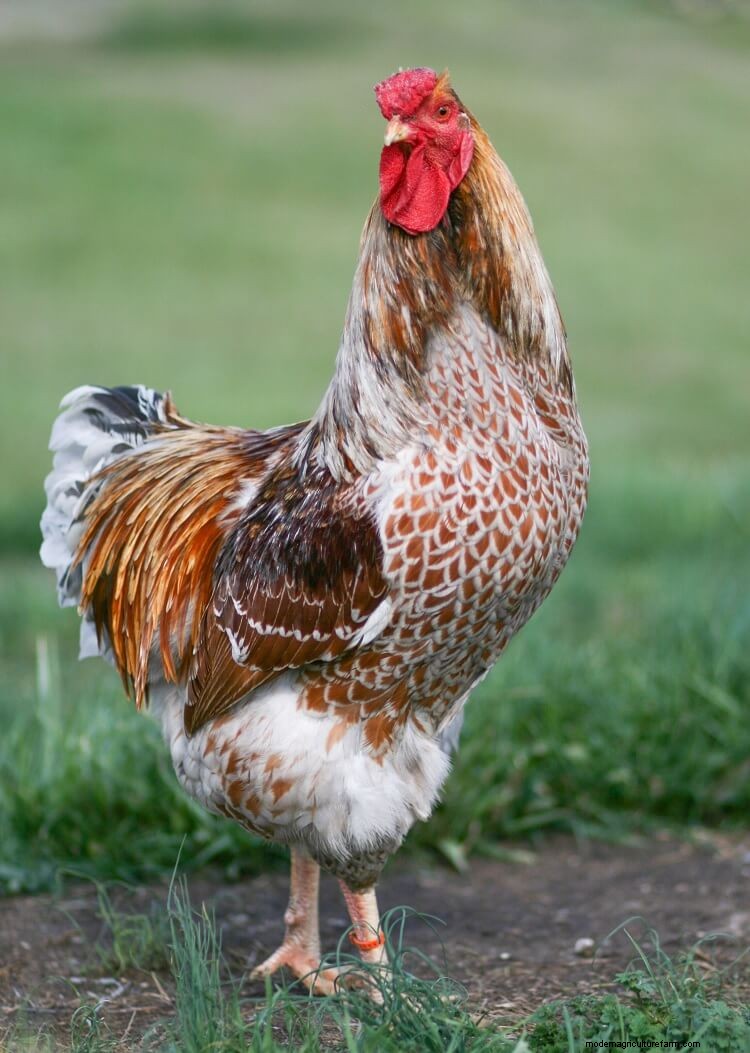
Witte Leghorn is een kleurvariant van de Leghorn – een oud ras uit Italië.
Omdat ze uit de Middellandse Zee komen, hebben ze het typische slanke en slanke lichaam.
Ze zijn een onafhankelijk ras dat het best te omschrijven is als luidruchtig en vluchtig. Het zijn zeker geen schootkippen.
Er zijn verschillende soorten Leghorn, maar het wit is de meest productieve laag . Het is bekend dat ze 4-6 grote witte eieren per week leggen.
The Leghorn prefers a warmer climate but can tolerate cool climates.
| White Leghorn |
|---|
| Main Use: Eggs |
| Yearly Egg Production: 250+ |
| Egg Color: White |
| Beginner Friendly: Yes |
| Temperament: Skittish |
| Noise Level: Loud |
| Preferred Climate: Warm Climates |
The White Rock is one of the Plymouth Rock varieties.
Created in the US as a dual purpose breed the Rocks are enduring success story. The White Rock has been a favorite with the broiler industry for many years.
It is a great chicken for small farms as it is people friendly and loves to be held which makes it great for kids and novices alike.
The hens are usually around 6lb in weight and good layers of large brown eggs (usually 4-5 per week).
They thrive in colder areas because of their dense feathering and are also available as bantams.
| White Rock |
|---|
| Main Use: Eggs |
| Yearly Egg Production: 250+ |
| Egg Color: Brown |
| Beginner Friendly: Yes |
| Temperament: Docile |
| Noise Level: Normal |
| Preferred Climate: Any |
The Whiting True Blue Chicken is a relatively new breed of chicken. It was created by Dr. Tom Whiting of Colorado in the late 1900s.
He created the chickens for two reasons:egg laying and fly tying.
Apparently the hackle feathers of the True Blue are of superb quality for tying fishing flies.
The hens are good layers and will give you 4 blue eggs each week.
True Blues are docile, curious and friendly towards humans. They are fast growing hens that are good flyers and love to be active. Their plumage is mixed colors with an occasional beard or single comb making an appearance.
| Whiting True Blue |
|---|
| Main Use: Eggs |
| Yearly Egg Production: 175-250 |
| Egg Color: Blue |
| Beginner Friendly: No |
| Temperament: Bold (Self Assured) |
| Noise Level: Normal |
| Preferred Climate: Any |
The Altsteirer is an ancient breed that can be traced back to at least the thirteenth century. They are also known as the Styrian as it was found in the Styrian region of Austria.
This is a very hardy and active dual purpose breed. They are constantly alert and love to free range and fly. Expect a friendly breed, but not lap chickens.
She will mature early and will weigh around 5.5lb.
The hens lay around three large white eggs each week and are not known for being broody.
There are two main varieties:white and partridge but there are other varieties too. All varieties are very rare.
| Altsteirer |
|---|
| Main Use: Dual Purpose |
| Yearly Egg Production: 100-170 |
| Egg Color: White |
| Beginner Friendly: Yes |
| Temperament: Friendly |
| Noise Level: Normal |
| Preferred Climate: Any |
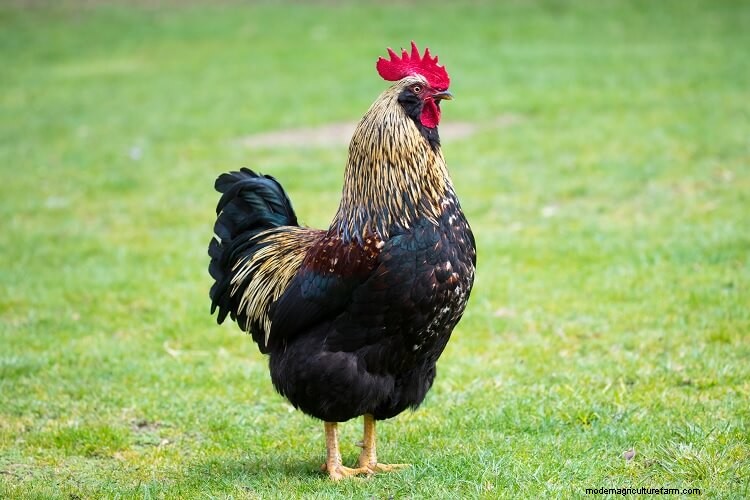
The Barnevelder was created in Holland specifically to lay a dark brown egg. Hens generally produce 3-4 large brown eggs each week (even through the winter).
They are a mix of several different breeds and are considered to be a dual purpose breed.
Once fully grown hens will lay around 5lb (there is a bantam variety too).
As for their personality they are calm and friendly with strong streaks of curiosity and intelligence.
They much prefer to be free ranging but will tolerate confinement pretty well as long as they have sufficient room and things to occupy them.
| Barnevelder |
|---|
| Main Use: Dual Purpose |
| Yearly Egg Production: 175-250 |
| Egg Color: Chocolate |
| Beginner Friendly: Yes |
| Temperament: Friendly |
| Noise Level: Normal |
| Preferred Climate: Any |
The Basque hen, also known as the Euskal Oiloa, originally comes from the Basque region of Spain.
This is a mountainous area where it is hard to survive. As a result Basque hens are hardy and a very thrifty forager.
There are five varieties with the Marraduna being the most common in the US.
These days it is a rare hen and efforts are being made to preserve this breed in their homeland. They are a remarkably friendly breed, and will not be afraid to jump into your lap to tell you about their day.
Hens will lay around 3 large brown eggs each week and will even lay during the winter.
| Basque |
|---|
| Main Use: Dual Purpose |
| Yearly Egg Production: 175-250 |
| Egg Color: Brown |
| Beginner Friendly: Yes |
| Temperament: Friendly |
| Noise Level: Normal |
| Preferred Climate: Warm Climates |

This is another member of the Wyandotte family that is currently popular. Although the blue lacing on red feathers seems to be the draw right now, this color variety can actually be dated back to the 1900s.
The Wyandotte is very well suited for cold climates as they have a rose comb and dense feathering to keep themselves warm through those long winter nights.
She is a large dual purpose hen and will weigh around 6lb.
Overall she is a peaceful, quiet and dependable breed, that lays 4 large cream/light brown eggs each week. Although they are docile they will not tolerate other breeds picking on them.
They do well in confinement as long as they have enough room, but prefer to free range when they can.
| Blue Laced Red Wyandotte |
|---|
| Main Use: Dual Purpose |
| Yearly Egg Production: 175-250 |
| Egg Color: Brown |
| Beginner Friendly: Yes |
| Temperament: Friendly |
| Noise Level: Quiet |
| Preferred Climate: Any |
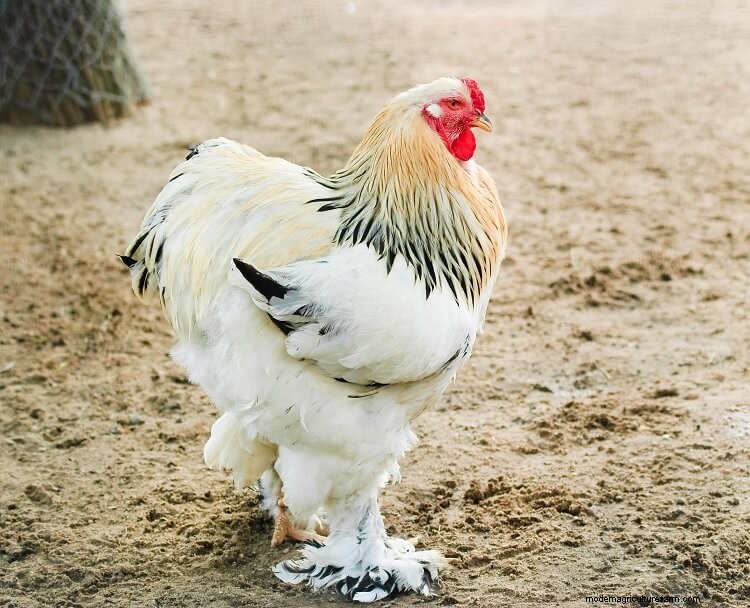
Welcome to the gentle giant of the chicken kingdom.
Brahmas can be huge with boys weighing up to 10lb and hens weighing 8lb!
Their personality is quiet, calm, docile and friendly. They are very tame and do well with children although their size can be a bit intimidating for some kids.
You can expect them to lay 3-4 medium brown eggs each week. And whilst they are not known for being broody, they do make good mothers.
The Brahma is available in both standard and bantam sizes.
| Brahma |
|---|
| Main Use: Dual Purpose |
| Yearly Egg Production: 100-170 |
| Egg Color: Brown |
| Beginner Friendly: Yes |
| Temperament: Friendly |
| Noise Level: Quiet |
| Preferred Climate: Any |
The Breda is the national bird of the Netherlands.
She is a striking breed and is truly without comparison in the poultry world.
Their head is shaped a bit like a crows’ head, with a large beak and cavernous nostrils. There is no comb just a red patch of skin and a small tuft
The Breda was very popular here in the US prior to the Civil War and then just faded away. They are slowly making a come-back but are considered endangered even in Holland.
Bredas weigh around 5-6lb and will lay 3 large white eggs each week. They are a shy chicken but are friendly, docile, alert and always curious.
| Breda |
|---|
| Main Use: Dual Purpose |
| Yearly Egg Production: 100-170 |
| Egg Color: White |
| Beginner Friendly: Yes |
| Temperament: Skittish |
| Noise Level: Normal |
| Preferred Climate: Any |
The Buckeye is the only American hen to have a pea comb . It is also the only breed that was created by a woman. They are called Buckeyes because their deep red plumage resembles the color of the buckeye nut.
They can thrive in cold climates because of their pea comb and tight feathering.
Buckeyes are more suited to free ranging, but should be kept in a safe area as they are not entirely predator savvy.
They are a good dual purpose breed, with hens laying 3-4 eggs a week.
She is an active breed and said to be great mousers. They are peaceful and friendly with their humans.
| Buckeye |
|---|
| Main Use: Dual Purpose |
| Yearly Egg Production: 175-250 |
| Egg Color: Brown |
| Beginner Friendly: Yes |
| Temperament: Docile |
| Noise Level: Quiet |
| Preferred Climate: Any |
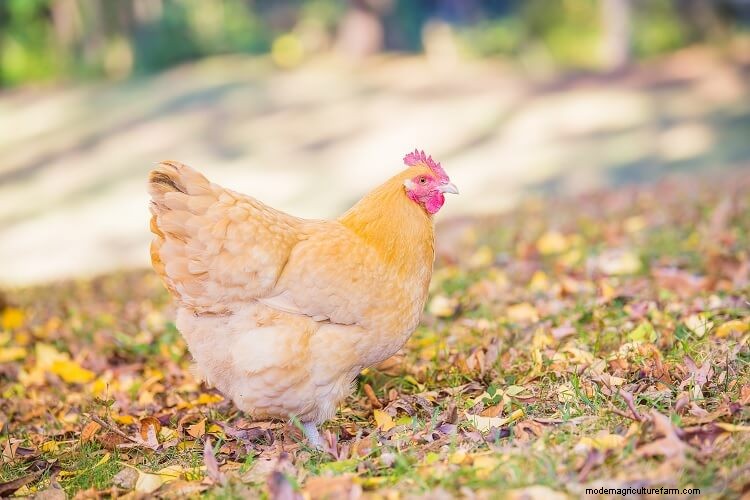
Welcome to the most popular variety of the Orpington tribe.
The Buff is loved all over the world and returns this love right back. She is a cuddly and calm breed that enjoys lap time and being picked up.
Buff Orpingtons are large chickens that weight around 8lb. She is a good layer putting out between 3-5 large light brown eggs per week.
The only negative thing to say about them is that they can be annoyingly broody, but if you want to raise chicks the Orpington will oblige.
Finally, they do need to be monitored for obesity as they are heavy feeders.
| Buff Orpington |
|---|
| Main Use: Dual Purpose |
| Yearly Egg Production: 175-250 |
| Egg Color: Brown |
| Beginner Friendly: Yes |
| Temperament: Friendly |
| Noise Level: Quiet |
| Preferred Climate: Any |
The Catalana originated in Spain and unusually for a Mediterranean breed is dual purpose.
Hens are good layers putting out 4 large white eggs a week and are rarely broody.
Unfortunately this breed has not caught on in the US yet, but they are very popular in Spain and Latin America.
She is known as an active and independent breed that loves to forage. They can be noisy so an urban environment is not for them. You will also notice she flys well and roosts high.
They come in two sizes:standard and bantam.
| Catalana |
|---|
| Main Use: Dual Purpose |
| Yearly Egg Production: 175-250 |
| Egg Color: White |
| Beginner Friendly: No |
| Temperament: Skittish |
| Noise Level: Loud |
| Preferred Climate: Warm Climates |
The Chantecler is Canadas first chicken breed.
They were bred in a Quebec monastery with the intention of producing a good dual purpose chicken that could survive the Canadian winters.
She tolerates the cold very well but does not like the heat so much.
Chanteclers have small wattles, a cushion comb and dense feathering. They come in two colors:white and partridge.
Overall they are a friendly and personable breed that is calm and gentle.
| Chantecler |
|---|
| Main Use: Dual Purpose |
| Yearly Egg Production: 175-250 |
| Egg Color: Brown |
| Beginner Friendly: Yes |
| Temperament: Docile |
| Noise Level: Quiet |
| Preferred Climate: Any |
The Colombian Wyandotte is one of the prettier Wyandotte varieties.
They are large birds and can weigh between 6-9lb.
In addition to this she is a good layer and will produce 4-5 large light brown eggs a week.
Hens do occasionally go broody and make attentive mothers.
Personality wise they are quiet, calm and docile. However they do not enjoy being picked up or held. They do equally well confined or free ranging but if they are allowed to roam they are great foragers.
They are suitable for an urban environment and come in standard and bantam sizes.
| Columbian Wyandotte |
|---|
| Main Use: Dual Purpose |
| Yearly Egg Production: 175-250 |
| Egg Color: Brown |
| Beginner Friendly: Yes |
| Temperament: Docile |
| Noise Level: Quiet |
| Preferred Climate: Any |
The Cuckoo Marans is one of several varieties of Marans chickens.
This French breed was developed over the centuries and an official standard was established in the 1920s.
The hens are very sought after because they lay chocolate colored eggs.
However they are not the most prolific layers, giving around 3 large per week.
This is a winter hardy chicken and a good forager. They are said to mature fairly quickly and once fully grown a hen will weight 7-8lb. They will tolerate confinement but prefer to free range.
| Cuckoo Marans |
|---|
| Main Use: Dual Purpose |
| Yearly Egg Production: 100-170 |
| Egg Color: Chocolate |
| Beginner Friendly: No |
| Temperament: Docile |
| Noise Level: Quiet |
| Preferred Climate: Any |
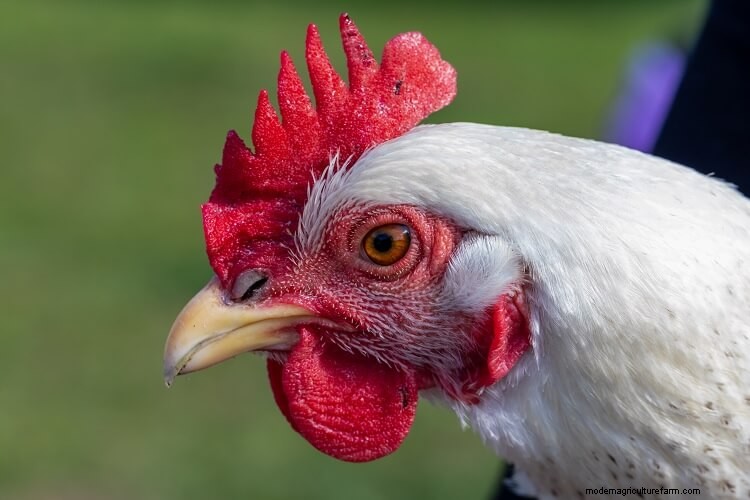
The Delaware was created around the 1940s and was destined to become the broiler chicken of the industry.
Originally called Indian Rivers they were extremely popular because they laid well and were fast growing. However they were surpassed in growth by the Cornish Cross, which became the broiler hen of the century.
Delawares are calm and curious hens that are personable and intelligent.
This sweet breed will be quite talkative too.
Available in both standard and bantam sizes this is a good homesteading breed. Hens will lay 4 large brown eggs a week and rarely go broody.
| Delaware |
|---|
| Main Use: Dual Purpose |
| Yearly Egg Production: 175-250 |
| Egg Color: Brown |
| Beginner Friendly: Yes |
| Temperament: Docile |
| Noise Level: Normal |
| Preferred Climate: Any |
The Red Cap is an old English breed. It is also known as a Coral cap.
They are an active but shy breed and are well suited for free ranging.
Derbyshire Redcaps are relatively pure since there has been little cross breeding with this breed. They have a stunning rose comb (hence the name Red Cap) and will reach around 6lb.
They were especially popular in the north of England however these days she is critically endangered.
The hens are not prolific layers but will give you a respectable 3-4 medium white eggs each week.
| Derbyshire Redcap |
|---|
| Main Use: Dual Purpose |
| Yearly Egg Production: 175-250 |
| Egg Color: White |
| Beginner Friendly: No |
| Temperament: Skittish |
| Noise Level: Normal |
| Preferred Climate: Any |
The Dominique hen is considered to be one of America’s oldest breeds.
They are also known as Pilgrim fowl as they are thought to have descended from the original breeds brought by the pilgrims.
She is a small hen and will only weigh around 5lb.
Their plumage is a black and white staggered barring pattern which helps them hide from predators. Their dense plumage and rose comb makes them a cold hardy breed.
In general they are a calm, docile and friendly breed. They are active, hardy and a fairly low maintenance breed.
Occasionally they will go broody and they make great mothers.
| Dominique |
|---|
| Main Use: Dual Purpose |
| Yearly Egg Production: 175-250 |
| Egg Color: Brown |
| Beginner Friendly: Yes |
| Temperament: Docile |
| Noise Level: Quiet |
| Preferred Climate: Any |
The exact history of the Dorking is unclear but they are thought to have originated from England. You may occasionally find this breed is called old five toes.
They evolved from the Landrace Chicken and remain a slow grower by today’s standards.
Hens will grow to around 6lb and Roosters will get heavier.
You should expect a shy and gentle chicken. They like to free range but will tolerate confinement fairly well.
They are one of the few hens with red earlobes that produce white eggs. They are attentive and devoted mothers and are quite broody.
| Dorking |
|---|
| Main Use: Dual Purpose |
| Yearly Egg Production: 175-250 |
| Egg Color: White |
| Beginner Friendly: No |
| Temperament: Docile |
| Noise Level: Quiet |
| Preferred Climate: Cold Hardy |
The Faverolles is an old French breed that is used as a dual purpose bird.
They have a happy personality, love to chat with you, are friendly, gentle and docile.
Their plumage is quite dense and they have beards, muffs and feathered feet which gives them an even fluffier appearance.
The most popular variety of Faverolles is the salmon color , which is more of a honey brown tone.
Hens are good layers of large tinted eggs. They do occasionally go broody and make good mothers.
The Faverolles love to free range but tolerate confinement with plenty of space.
| Faverolles |
|---|
| Main Use: Dual Purpose |
| Yearly Egg Production: 175-250 |
| Egg Color: Brown |
| Beginner Friendly: Yes |
| Temperament: Friendly |
| Noise Level: Normal |
| Preferred Climate: Any |
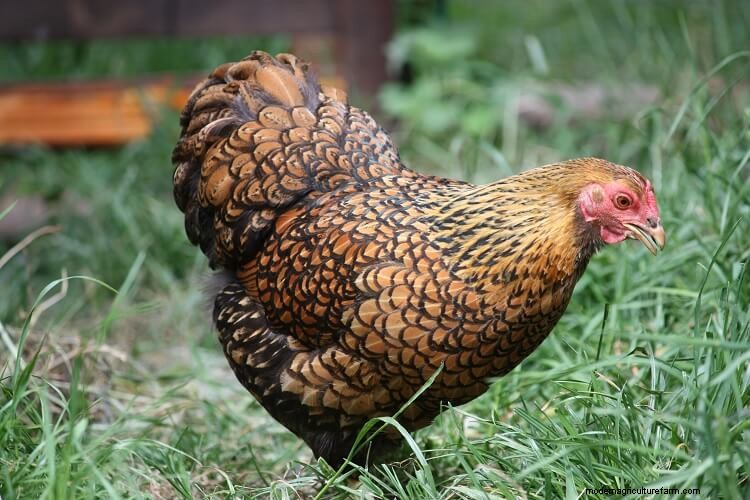
The Golden Laced Wyandotte is one of Americas’ premier breeds!
She is cold hardy, productive and low maintenance.
Once fully grown she will reach around 6lb, however if you are restricted with space then bantams are available.
They are an independent minded hen and prefer the company of their own breed. Whilst she is friendly enough to humans, she does not enjoy being picked up or cuddled.
Their independent nature and low maintenance requirements makes them ideal for novices and 4H programs.
| Golden Laced Wyandotte |
|---|
| Main Use: Dual Purpose |
| Yearly Egg Production: 175-250 |
| Egg Color: Brown |
| Beginner Friendly: Yes |
| Temperament: Bold (Self Assured) |
| Noise Level: Quiet |
| Preferred Climate: Any |
Icelandic chickens are a rare gem . They are almost genetically pure which seems to keep them pretty healthy and disease free.
They were left in Iceland by the Vikings who had selected the best utilitarian chickens they could find. As a Landrace Chicken there is no standard and they come in a wide variety of colors, patterns and plumage types.
As you would expect, they are great foragers and can virtually feed themselves. They are extremely hardy to most climates, fly well and very predator savvy.
Given their history this breed will never be cuddly, but they will become friendly and trusting of you if given time.
Hens will only weigh around 3lb.
| Icelandic |
|---|
| Main Use: Dual Purpose |
| Yearly Egg Production: 100-170 |
| Egg Color: White |
| Beginner Friendly: Yes |
| Temperament: Bold (Self Assured) |
| Noise Level: Normal |
| Preferred Climate: Cold Hardy |
Unfortunately the Iowa Blue is a rare breed these days.
They were created around the 1900s in Iowa and quickly gained popularity in small farms and homesteads.
This is a large breed that will weigh between 5-6lb. Hens are good layers and will give you 3-4 eggs each week. Also the ladies have a tendency towards broodiness and make good mothers.
Roosters are known for being great flock defenders and their nickname is hawk fighter!
The breed does best in a free range situation as it is a great forager and alert to danger.
You can expect a fairly calm and docile chicken that is tolerant of a wide range of temperatures and environments.
| Iowa Blue |
|---|
| Main Use: Dual Purpose |
| Yearly Egg Production: 100-170 |
| Egg Color: Brown |
| Beginner Friendly: Yes |
| Temperament: Docile |
| Noise Level: Normal |
| Preferred Climate: Any |
The Java is the second oldest breed in the US behind the Dominique. Despite their name they were developed in the US sometime around the mid-1800s.
They were critically endangered at one time but are slowly making a comeback.
She is very well suited to small farms and homesteads.
They are a dual purpose chicken and will lay 3 large brown eggs a week.
This breed loves to range and when allowed they will supplement their diet very well. You can find them in three varieties (black, white and mottled).
Expect a friendly, docile and calm breed that is easily handled.
| Java |
|---|
| Main Use: Dual Purpose |
| Yearly Egg Production: 100-170 |
| Egg Color: Brown |
| Beginner Friendly: Yes |
| Temperament: Docile |
| Noise Level: Normal |
| Preferred Climate: Any |
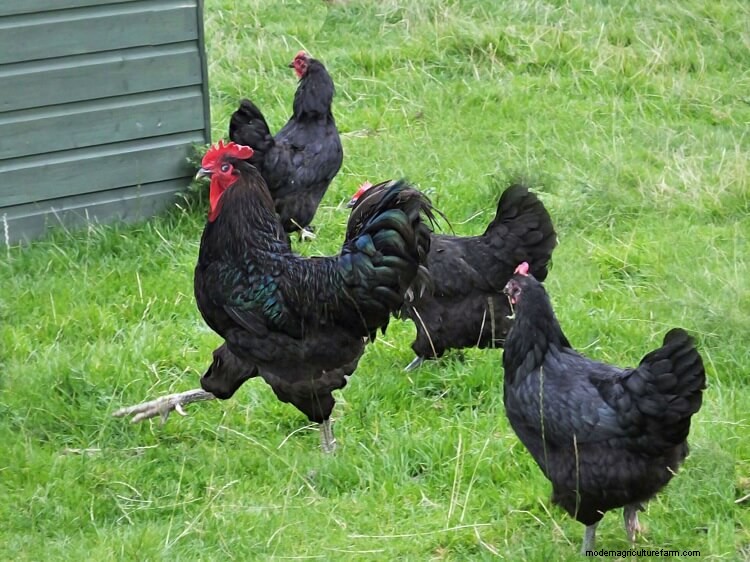
The Jersey Giant was created in New Jersey back in the 1800s.
It was originally intended to rival the turkey’s place at the table.
As you would expect this is a large chicken that stands around 2 feet tall. Males will weigh 13-15lb and hens around 11lb.
Given their size you will need to have larger pens, doors and nest boxes available for them. Also make sure to place perches slightly lower to the floor.
Jersey Giants are calm, gentle and love to forage. This is a good thing as they are expensive to feed so letting them roam will reduce their feed bill slightly. They are not known for being broody, but sadly when they do, they often break the eggs with their weight or step on the chicks accidentally.
They are suitable for beginners and children – although their size can be a bit intimidating!
| Jersey Giant |
|---|
| Main Use: Dual Purpose |
| Yearly Egg Production: 175-250 |
| Egg Color: Brown |
| Beginner Friendly: Yes |
| Temperament: Docile |
| Noise Level: Normal |
| Preferred Climate: Any |
The Lavender Orpington is one of the newer additions to the Orpington family.
They were first bred in the 1990s and have really taken off in popularity.
The Lavender color is due to a recessive diluting gene that dilutes black to a pale grey/pearl grey or lavender.
Orpingtons are large fluffy hens that look enormous. They are a dual purpose hen but the lavender strain often is an exhibition or show bird too.
Hens are notoriously broody and make great mothers and will raise most eggs placed under them. When they are not broody they will lay 3-4 large tinted eggs each week.
Orpingtons are inclined to be lazy and whilst they do forage they will prefer to sit by the feeder. Their weight should be monitored as obese hens can have serious problems with egg laying.
They are gentle, quiet, docile and make great beginner chickens.
| Lavender Orpington |
|---|
| Main Use: Dual Purpose |
| Yearly Egg Production: 175-250 |
| Egg Color: Brown |
| Beginner Friendly: Yes |
| Temperament: Docile |
| Noise Level: Quiet |
| Preferred Climate: Any |
The Light Brahma is a color variation of the Brahma.
They have a light colored plumage and are quite large. However despite their appearance they are a gentle giant!
Brahmas are calm, friendly and quiet, so are well suited for beginners.
The hens are good layers and will produce around 4 brown eggs per week.
| Light Brahma |
|---|
| Main Use: Dual Purpose |
| Yearly Egg Production: 100-170 |
| Egg Color: Brown |
| Beginner Friendly: Yes |
| Temperament: Friendly |
| Noise Level: Quiet |
| Preferred Climate: Any |
The Marsh Daisy is sadly in need of people to help conserve the breed.
She was created in the 1800s in Lancashire (England) and is a beautiful hen well suited to small farms and homesteads.
The name Marsh Daisy may come from their oversized rose comb which is said to look like a Marsh Daisy.
They are slow to mature but they are very economical since they love to free range and are very active foragers.
Although they cannot really be described as friendly, they are pretty calm yet aloof.
Hens weigh around 5.5lb and will lay 2-3 medium tinted eggs each week. They are occasionally broody and make good mothers.
They come in five color varieties but some are very rare and hard to find.
| Marsh Daisy |
|---|
| Main Use: Dual Purpose |
| Yearly Egg Production: 100-170 |
| Egg Color: Cream |
| Beginner Friendly: Yes |
| Temperament: Bold (Self Assured) |
| Noise Level: Normal |
| Preferred Climate: Any |
The Minorca was developed in the late 1700s and comes to us from the Balearic Islands of the Mediterranean.
Also known as the Moorish chicken, or the Red faced Black Spanish, they are the largest of the Mediterranean breeds standing tall with a long tail.
Notably they have large white earlobes and can have either a single or rose comb.
Hens have a good temperament and really enjoy their humans. They can still be a bit flighty on occasions but are generally calm and docile.
You can expect excellent foragers that prefer warmer climates.
| Minorca |
|---|
| Main Use: Dual Purpose |
| Yearly Egg Production: 175-250 |
| Egg Color: White |
| Beginner Friendly: No |
| Temperament: Skittish |
| Noise Level: Normal |
| Preferred Climate: Warm Climates |
The New Hampshire breed was created in the State of New Hampshire around 1918 as a dual purpose hen.
Unfortunately they have always been overshadowed by the Rhode Island Red which was created around the same time.
They are friendly hens that tend to make good pets and are easy to tame (so are ideal for kids). However they can be food aggressive with other breeds, so be careful when mixing with other breeds.
The hens weigh in at 6.5lb and are good layers of large tinted eggs. They also have a broody tendency and make great mothers.
New Hampshires come in both standard and bantam sizes, but both are hard to find.
| New Hampshire |
|---|
| Main Use: Dual Purpose |
| Yearly Egg Production: 250+ |
| Egg Color: Brown |
| Beginner Friendly: Yes |
| Temperament: Docile |
| Noise Level: Normal |
| Preferred Climate: Any |
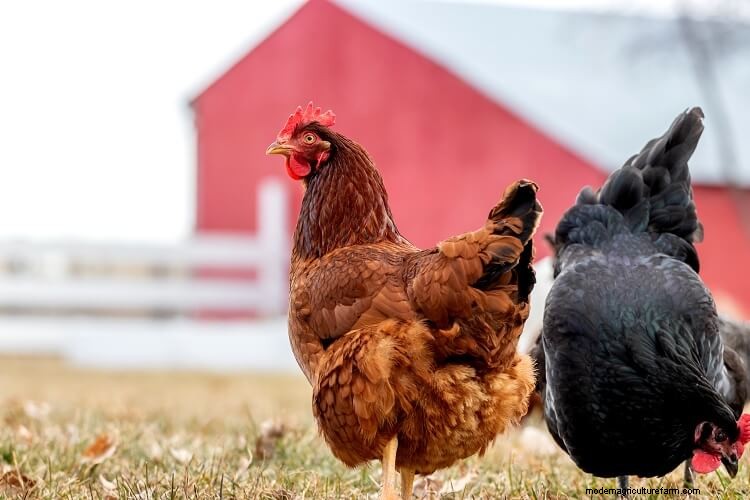
To this day the Orpington breed is a favorite of many small farms and backyard poultry enthusiasts.
This is a large dual purpose chicken that is a prolific egg layer.
She will make a great attentive mother too.
They are large and have copious feathering which comes in several varieties – buff is regarded as the favorite.
Orpingtons are docile, gentle and calm. They are quiet too so urban living could be for them.
This is a great hen for novices and children and will frequently become lap chickens.
| Orpingtons |
|---|
| Main Use: Dual Purpose |
| Yearly Egg Production: 175-250 |
| Egg Color: Brown |
| Beginner Friendly: Yes |
| Temperament: Docile |
| Noise Level: Quiet |
| Preferred Climate: Any |
The Red Ranger is a dual purpose hybrid chicken that was initially made for the meat market.
Hens are good layers of large brown eggs and will usually lay 3-4 each week.
She is rarely broody and unlike the Cornish Cross, this breed will live for several years.
These hens love to free range and are excellent foragers which can help reduce feed costs.
| Red Ranger |
|---|
| Main Use: Dual Purpose |
| Yearly Egg Production: 175-250 |
| Egg Color: Brown |
| Beginner Friendly: No |
| Temperament: Docile |
| Noise Level: Normal |
| Preferred Climate: Any |

Next to the Orpington, this is possibly the most well known chicken breed worldwide
This breed was created in the mid 1800s in Rhode Island – their fame is such that it is the state chicken there.
They are excellent layers and are rarely broody. They do well in confinement or free range and are a very low maintenance chicken to keep.
Rhode Island Reds are docile and friendly with humans, but can be pushy with other breeds. They can be quite noisy too so urban living really would not suit them.
| Rhode Island Red |
|---|
| Main Use: Dual Purpose |
| Yearly Egg Production: 250+ |
| Egg Color: Brown |
| Beginner Friendly: Yes |
| Temperament: Bold (Self Assured) |
| Noise Level: Loud |
| Preferred Climate: Any |
The Sicilian Buttercup is an unusual looking breed.
Their comb is shaped more like a crown and it is the only breed with such a comb . Also the plumage of the hens and roosters is totally different with the ladies having a spangled appearance.
Originating in Sicily, this breed has the typical slender Mediterranean build. Although it can be used as a dual purpose hen, it is not very meaty. They tolerate heat very well but do not tolerate confinement at all as they are an active and restless chicken.
Egg laying is considered to be low to moderate with 2-3 large white eggs per week. The hens are not broody by nature.
Buttercups have a very good feed conversion ratio which makes them fairly inexpensive to feed.
| Sicilian Buttercup |
|---|
| Main Use: Dual Purpose |
| Yearly Egg Production: 100-170 |
| Egg Color: White |
| Beginner Friendly: No |
| Temperament: Bold (Self Assured) |
| Noise Level: Normal |
| Preferred Climate: Warm Climates |
This variety of Wyandotte is actually the first of its breed.
The breeders were looking for a good dual purpose hen since none existed at that time.
Wyandottes were created to thrive in the cold winters of New York and Michigan.
Hens will lay 4 large eggs each week and are not known for being broody. Their personality is a little distant although they are friendly enough with humans.
This variety too is available in standard and bantam sizes.
| Silver Laced Wyandotte |
|---|
| Main Use: Dual Purpose |
| Yearly Egg Production: 175-250 |
| Egg Color: Brown |
| Beginner Friendly: Yes |
| Temperament: Bold (Self Assured) |
| Noise Level: Quiet |
| Preferred Climate: Any |
The Speckled Sussex is one variety of the very old Sussex breed. This breed has been around since the Roman invasion of Britain.
This is a dual purpose chicken that dresses out to a good 7lb for hens.
Hens are good layers but they do have a slight tendency towards broodiness.
Personality-wise they are a calm, docile and friendly bird. They do well with children and can become tame enough to sit in your lap. They are quite cold hardy but do not enjoy the heat so much. If allowed to free range they are excellent foragers but they do tolerate confinement well.
They are available in both standard and bantam sizes.
| Speckled Sussex |
|---|
| Main Use: Dual Purpose |
| Yearly Egg Production: 250+ |
| Egg Color: Brown |
| Beginner Friendly: Yes |
| Temperament: Docile |
| Noise Level: Normal |
| Preferred Climate: Cold Hardy |
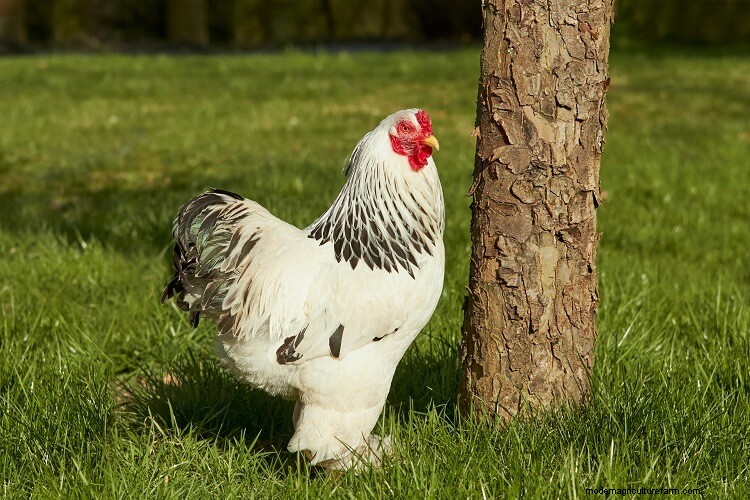
The Sussex is an ancient English hen and has been around for centuries.
They were kept as a dual purpose chicken and in their heyday supplied London with meat for the markets.
This is a dual purpose breed that will put out 4-5 large brown eggs a week. Hens are known for being a bit broody but they do make great mothers.
They do well in confinement but excel when allowed to free range and this will reflect in the feed bill (they are excellent scavengers).
Overall they are a mellow, low maintenance breed that is available in standard or bantam size and is suitable for kids or as a lap chicken.
| Sussex |
|---|
| Main Use: Dual Purpose |
| Yearly Egg Production: 250+ |
| Egg Color: Brown |
| Beginner Friendly: Yes |
| Temperament: Docile |
| Noise Level: Normal |
| Preferred Climate: Cold Hardy |
The Turken, also known as the Naked Neck, is a strange looking chicken.
They have no neck or hackle feathers and sparse feathering around their vent.
It is thought they originated from Transylvania, which explains their other nicknames:the Transylvanian naked neck or Kaalnek.
They like to forage and roam, but they will tolerate confinement. If they are allowed to range they are good foragers, active and vigorous. They are generally a placid and calm hen.
This breed does better in warmer areas but will be hardy enough in cold areas with some protection.
| Turken |
|---|
| Main Use: Dual Purpose |
| Yearly Egg Production: 100-170 |
| Egg Color: Brown |
| Beginner Friendly: No |
| Temperament: Friendly |
| Noise Level: Normal |
| Preferred Climate: Any |
The Vorwerk was created in Germany around the 1900s. Its purpose was as a dual breed breed.
It is a handsome chicken with black and buff plumage. A hen weighs around the 5lb mark with roosters around 7lb. They are fast to grow and mature and are very suitable for small farms and homesteads. She is winter hardy to most climates and available in both standard and bantam sizes.
The hens are decent layers of cream eggs – around 3 per week and they lay well throughout the winter. They do like to be active so free ranging is best for them as they are good foragers.
Vorwerks are a calm, docile and friendly hen which makes them good for novices and children.
| Vorwerk |
|---|
| Main Use: Dual Purpose |
| Yearly Egg Production: 100-170 |
| Egg Color: Cream |
| Beginner Friendly: Yes |
| Temperament: Bold (Self Assured) |
| Noise Level: Normal |
| Preferred Climate: Any |
Welsummers originated in Holland around the 1920s and remain very popular in Europe.
Here in the US they are gaining popularity as a dual purpose bird that is great for small farms and homesteads.
They are decent layers and produce 4-5 large dark brown eggs each week. The darkness of their eggs can rival some Marans.
The Welsummer will tolerate confinement but do best when free ranging as they are excellent foragers.
They are a low maintenance breed that is smart, curious and friendly with humans. They can be a bit raucous so urban living is not really for them.
| Welsummer |
|---|
| Main Use: Dual Purpose |
| Yearly Egg Production: 175-250 |
| Egg Color: Chocolate |
| Beginner Friendly: Yes |
| Temperament: Docile |
| Noise Level: Normal |
| Preferred Climate: Any |
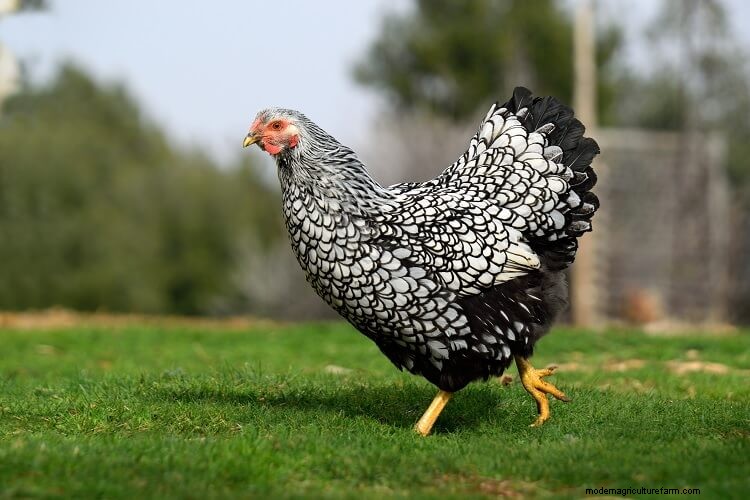
The Wyandotte chicken came into being in the late 1800s. It was created to be a dual purpose breed providing for both meat and eggs.
There is a wide range of varieties to the Wyandottes which we have mentioned here.
They are a large breed with hens weighing around 6lb and roosters around 8lb. The hens are good layers of light brown eggs, usually around 4 per week.
Wyandottes are an aloof chicken, friendly to a point but they do not really enjoy being picked up or held.
They are good for novices as they are low maintenance.
| Wyandotte |
|---|
| Main Use: Dual Purpose |
| Yearly Egg Production: 175-250 |
| Egg Color: Brown |
| Beginner Friendly: Yes |
| Temperament: Bold (Self Assured) |
| Noise Level: Quiet |
| Preferred Climate: Any |
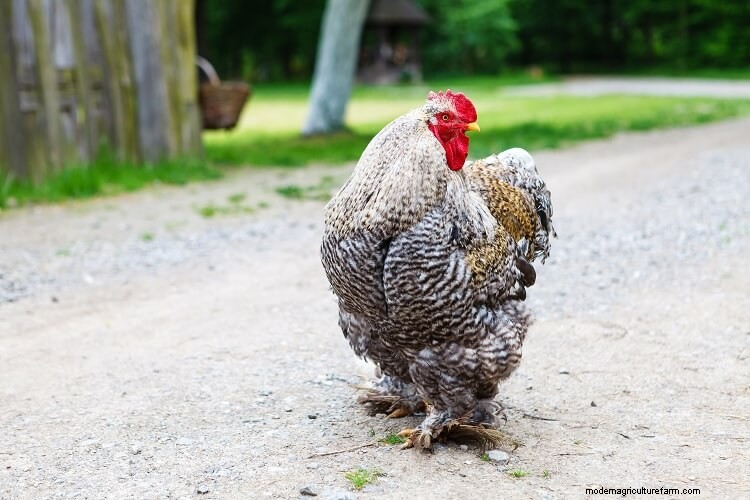
The Cochin was one of the breeds responsible for the hen fever of the late 1800s.
They were new and novel and were crossed with just about every breed known, giving us the richness of breeds that we see today. The Cochin is a large bird and is covered head to toe in feathers. They are slow moving so need to be kept safe from predators.
Their personality is friendly, calm and docile. They love to be lap chickens and adore children.
On the egg laying side, hens are not the best performers. However they do have a tendency towards broodiness so make great moms.
There are also Bantams available.
| Cochin |
|---|
| Main Use: Pet |
| Yearly Egg Production: 100-170 |
| Egg Color: Brown |
| Beginner Friendly: Yes |
| Temperament: Friendly |
| Noise Level: Quiet |
| Preferred Climate: Any |
Depending on which country you live in, the Frizzle may, or may not be a breed.
Here in the US they are not considered a breed but a feather variation of whichever breed they are hatched from (Polish and Cochins are quite prone to frizzles). Just remember that their feathers can be broken easily and the curling affects their ability to fly.
Their feathers curl up and away from the body, looking like a bad hair-do!
You can have your Frizzle in standard or bantam size.
They are a sweet and gentle breed that enjoys being with their humans and make very good show or exhibition birds.
This chicken is a good little forager who enjoys free ranging.
Egg laying will vary on the breed, but expect an average of 3 white eggs each week.
| Frizzle |
|---|
| Main Use: Pet |
| Yearly Egg Production: 100-170 |
| Egg Color: White |
| Beginner Friendly: Yes |
| Temperament: Friendly |
| Noise Level: Normal |
| Preferred Climate: Any |
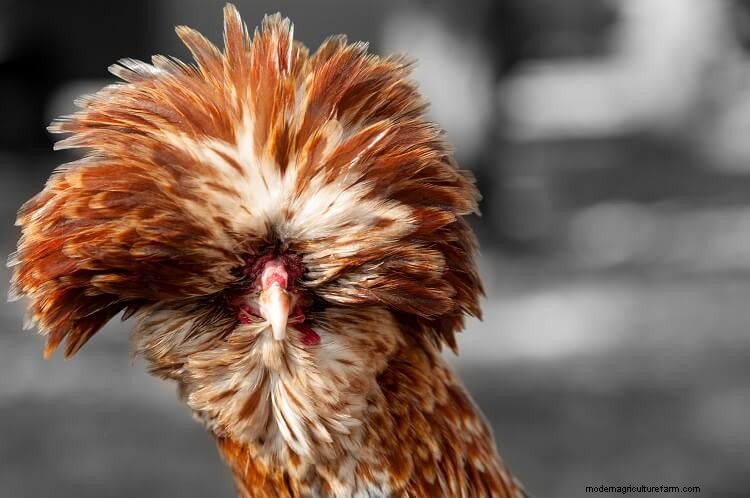
The Polish has an unmistakable appearance – the girls have pom pom hairdos and the boys look like bad hair days!
You may have heard this breed referred to as a Tophat or Paduan.
They are gentle, quiet, friendly and are well suited for children. They are mainly used for ornamental or show purposes these days, but they do lay fairly well. Hens can lay 3-4 large eggs each week.
Just remember that their head feathers can cause problems as they impinge upon the eyesight, so these chickens should be confined or supervised in free ranging.
| Polish |
|---|
| Main Use: Pet |
| Yearly Egg Production: 100-170 |
| Egg Color: White |
| Beginner Friendly: Yes |
| Temperament: Friendly |
| Noise Level: Normal |
| Preferred Climate: Any |
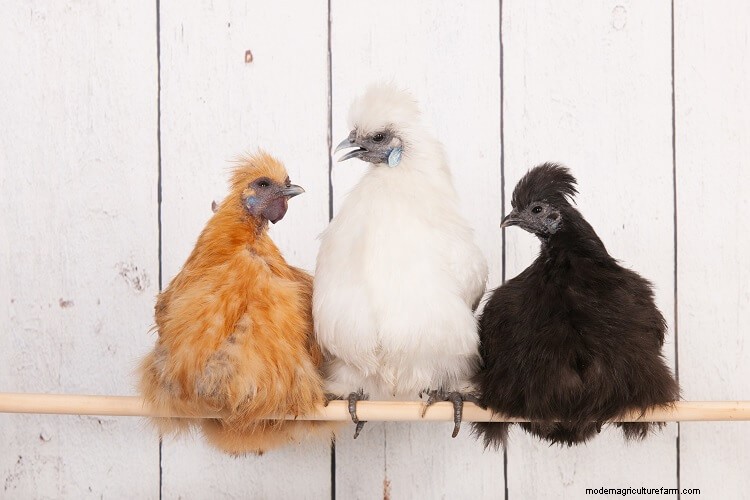
The Silkie is a much loved breed all over the world. Originating in China, this breed has become one of the most popular chickens of all time.
They are best known for their furry rather than feathered look. Kids just love to touch them as they also feel furry.
This breed makes for great pets since they love to cuddle, quiet and are very friendly. The hens are frequently used as broodies since they love to sit on eggs and they make very attentive mothers.
Since they cannot fly they are best confined or if left to free range they must be supervised.
Silkies come in a variety of colors and some have beards.
| Silkie |
|---|
| Main Use: Pet |
| Yearly Egg Production: 100-170 |
| Egg Color: Cream |
| Beginner Friendly: Yes |
| Temperament: Friendly |
| Noise Level: Quiet |
| Preferred Climate: Any |
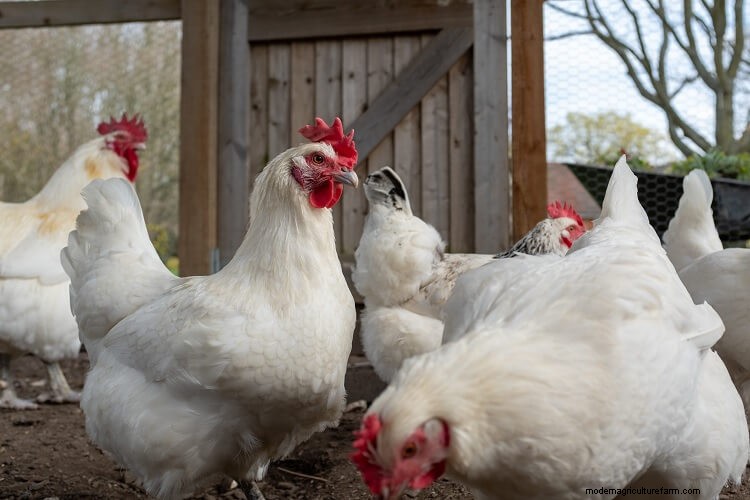
The Breese chicken originated in France and is the premier meat chicken in the world.
Raising this hen is very strictly controlled and only farmers that conform to the specifications are allowed to sell their chickens as Bresse.
The American Bresse has been around for a few years now. It is the same breed but cannot be called a Bresse as it would violate trade standards.
This chicken breed is primarily a meat breed however hens do lay a moderate amount of cream colored eggs each year.
There are some color variations, but the most well-known color is white. They can be flighty and aloof with people.
| Bresse |
|---|
| Main Use: Meat |
| Yearly Egg Production: 100-170 |
| Egg Color: Cream |
| Beginner Friendly: No |
| Temperament: Friendly |
| Noise Level: Normal |
| Preferred Climate: Any |
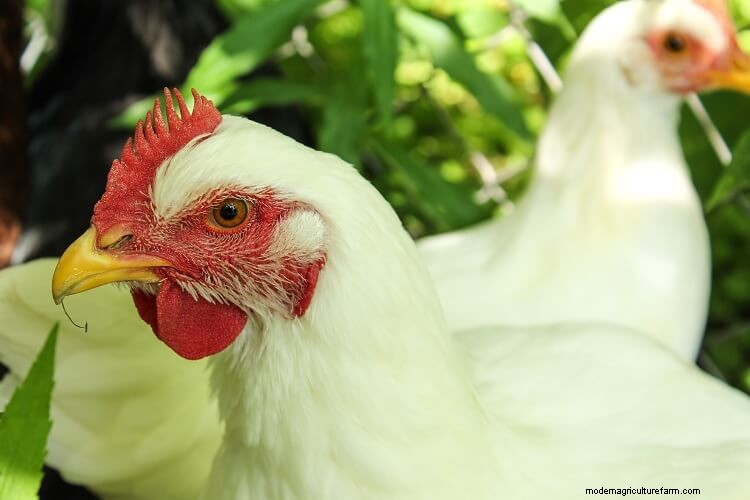
The Cornish Cross broiler was created by the poultry industry over 50 years ago and still dominates the meat market today.
This chicken is a cross between the commercial Cornish hen and a White Plymouth Rock.
Their growth rate is phenomenal so unfortunately they do not live much beyond six months.
Generally they are docile and calm. They do not forage but would rather hang out by the feeder. On the rare occasion that a hen lives to produce eggs, they will lay 2-3 small light brown eggs each week.
| Cornish Cross |
|---|
| Main Use: Meat |
| Yearly Egg Production: 100-170 |
| Egg Color: Brown |
| Beginner Friendly: No |
| Temperament: Docile |
| Noise Level: Quiet |
| Preferred Climate: Any |
Although often nicknamed Russians, this breed actually came from Persia.
However they gained popularity in the early 1800s by a Russian count named Orloff-Techesmensky.
They are more of a meat bird since the eggs are small and few in number.
As you might expect, they are well suited to cold climates and are found in several color varieties.
They are a calm and quiet chicken but not overly friendly or docile.
In the US they are rare and do not have a place in the American Poultry Association. Worldwide they are in need of conservation.
| Orloff |
|---|
| Main Use: Meat |
| Yearly Egg Production: 100-170 |
| Egg Color: Brown |
| Beginner Friendly: No |
| Temperament: Docile |
| Noise Level: Quiet |
| Preferred Climate: Cold Hardy |

Meet the first true bantam in this guide.
She originates from Belgium and is a popular choice for those without much space.
The Barbu D’Uccle is a delightfully friendly little hen that enjoys being held. She will frequently perch on your shoulder and talk to you – needless to say she is a perfect chicken for kids.
They come in a variety of colors with mille fleur being the most desirable. They have beards, muffs, vulture hocks and feathered feet, so an all round profusion of feathers!
The hens have a mixed reputation as layers. I have found them to lay (small cream eggs) fairly consistently through the warmer months shutting down for winter.
| Barbu d’Uccle |
|---|
| Main Use: Bantam |
| Yearly Egg Production: 175-250 |
| Egg Color: Cream |
| Beginner Friendly: Yes |
| Temperament: Friendly |
| Noise Level: Normal |
| Preferred Climate: Any |
These little chickens are true bantams.
They are known as Sablepoot in the UK and can be traced back to the sixteenth century.
They look similar to the Barbu d’Uccle with feathered feet and vulture hocks.
These hens are very friendly and calm and do well with children. They are good foragers, but really should be kept in a covered area for their own safety.
Hens weigh around 27oz and are good summer layers giving you 3 small white eggs each week.
| Booted Bantam |
|---|
| Main Use: Bantam |
| Yearly Egg Production: 100-170 |
| Egg Color: White |
| Beginner Friendly: Yes |
| Temperament: Friendly |
| Noise Level: Normal |
| Preferred Climate: Any |
Despite their name the Dutch bantam did not originate in Holland.
They are a true bantam and have no large counterpart.
Hens weigh a slight 14oz and there is plenty of variety with over 25 color variations.
The ladies are fair to moderate layers of small white eggs. They also make great broodies and are wonderful mothers.
When raised from chicks they can be very tame and friendly with a good temperament.
The breed is not particularly winter hardy, nor do they enjoy too much heat. They should have plenty of room as they are active and like to fly.
| Dutch Bantam |
|---|
| Main Use: Bantam |
| Yearly Egg Production: 100-170 |
| Egg Color: White |
| Beginner Friendly: Yes |
| Temperament: Docile |
| Noise Level: Normal |
| Preferred Climate: Any |
The Nankin is probably the oldest true bantam.
Records go back to the 1500s but the Nankin was known long before then.
This is a tiny breed weighing only 22-24oz and is unfortunately critically endangered worldwide.
She is a talkative, curious and social bird that likes to be active. They can be found with either a single or rose comb (better for cold climates). These little hens always range together as a flock to improve their chances of survival.
The hens will lay small cream eggs and are exceptional sitters, so much so that they are frequently used on English game farms to raise partridges.
| Nankin |
|---|
| Main Use: Bantam |
| Yearly Egg Production: 100-170 |
| Egg Color: Cream |
| Beginner Friendly: Yes |
| Temperament: Friendly |
| Noise Level: Normal |
| Preferred Climate: Any |
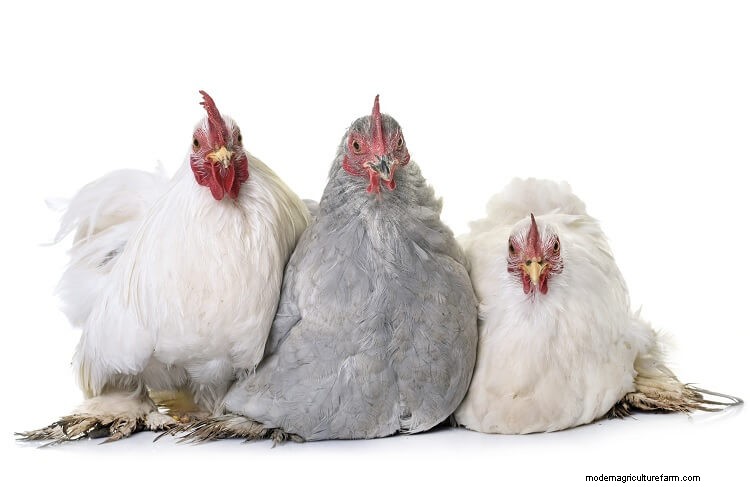
The Pekin bantam is a British breed that is known elsewhere as a Cochin bantam. As their name suggests, they are a true bantam and there is no standard counterpart.
They are well feathered, but despite all that feathering they really do not tolerate winters too well.
This bantam breed is gentle and docile but will only lay 2 small white eggs a week.
There are several color varieties to choose from and can become great pets (especially for children).
| Pekin Bantam |
|---|
| Main Use: Bantam |
| Yearly Egg Production: <100 |
| Egg Color: White |
| Beginner Friendly: Yes |
| Temperament: Friendly |
| Noise Level: Normal |
| Preferred Climate: Any |
The Sebright is a very distinctive chicken which was developed in the 1800s in England.
They are a true bantam and the oldest English bantam.
Interestingly the roosters are hen feathered which means there is no plumage difference in the sexes. The chicken has a rose comb and stunning plumage – there are two color varieties (gold and silver).
The hen will weigh in around 20oz and is a poor layer.
Unfortunately there is a high mortality rate for chicks in this breed making them difficult to raise – so not a hen for a novice.
These little birds are friendly, active and very social. Roosters are not known for aggression at all.
| Sebright |
|---|
| Main Use: Bantam |
| Yearly Egg Production: <100 |
| Egg Color: White |
| Beginner Friendly: No |
| Temperament: Friendly |
| Noise Level: Normal |
| Preferred Climate: Any |
The Serama owns the title of the smallest chicken in the world . These tiny chickens are generally under 500gm (17oz) but there are some that are only half this size.
Although they are small in stature they have a big personality.
This breed is friendly, gentle, loves human company and is quiet. They should be kept in confinement for their safety.
The Serama hen will lay 3-4 small eggs each week and likes to be broody.
| Serama |
|---|
| Main Use: Bantam |
| Yearly Egg Production: 100-170 |
| Egg Color: Cream |
| Beginner Friendly: No |
| Temperament: Friendly |
| Noise Level: Normal |
| Preferred Climate: Warm Climates |
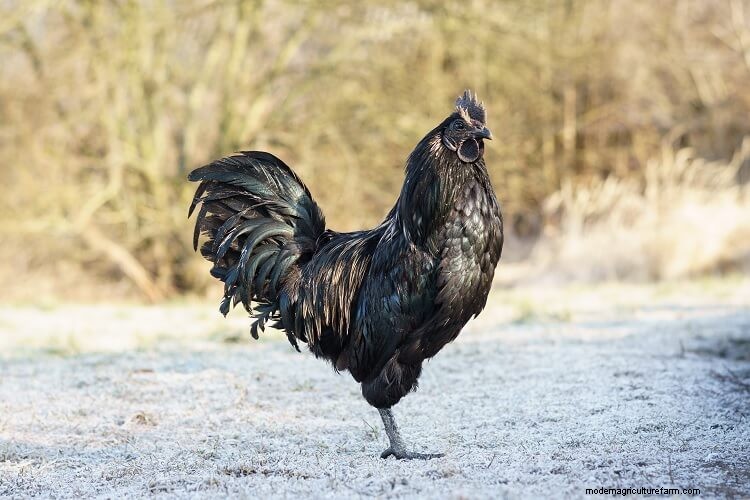
This all black melanistic chicken originated in the Indonesian Islands.
The melanoma means that everything is black:muscles, organs, heart and even the tongue!
Because they are black they are highly revered in their homeland where they are considered to have magical properties.
They are standard sized hens and weigh around 3.5-4.5lb.
The hens are cyclic egg layers which means they go through a cycle of laying eggs then stop for a while before resuming.
Because of this they are considered poor layers since they only put out around 80 cream colored eggs a year.
| Ayam Cemani |
|---|
| Main Use: Exhibition |
| Yearly Egg Production: <100 |
| Egg Color: Cream |
| Beginner Friendly: No |
| Temperament: Friendly |
| Noise Level: Normal |
| Preferred Climate: Warm Climates |
The Brabanter is another old and distinguished breed.
Their name comes from the Brabant area which covers part of Belgium and Holland.
There are both standard and bantam sizes available, but both are rare these days.
A standard hen weighs between 5-6lb and will lay white eggs in moderate amounts.
She is a shy chicken, but can be friendly. Roosters are highly strung.
| Brabanter |
|---|
| Main Use: Exhibition |
| Yearly Egg Production: 100-170 |
| Egg Color: White |
| Beginner Friendly: Yes |
| Temperament: Docile |
| Noise Level: Normal |
| Preferred Climate: Any |
The Crevecoeur is an ancient French breed that is now critically endangered.
It was originally a dual purpose breed and can still be used as such, but today it is mainly an ornamental breed.
They have an all black plumage with a head crest that almost hides the rooster V shaped comb. They are a medium sized standard chicken with hens weighing around 6.5lb.
Hens are moderate layers of medium sized white eggs (roughly 3 each week).
Their personality is calm, docile and active. They do tolerate confinement fairly well, but enjoy free ranging too.
| Crevecoeur |
|---|
| Main Use: Exhibition |
| Yearly Egg Production: 100-170 |
| Egg Color: White |
| Beginner Friendly: Yes |
| Temperament: Docile |
| Noise Level: Quiet |
| Preferred Climate: Any |
The Cubalaya was developed in Cuba from Filipino poultry.
It has a pea comb and a very distinctive lobster tail.
They were used for cock fighting in their homeland as roosters are known for being aggressive. However towards people, the Cubalaya is friendly, curious and remarkably tame.
In the US this breed is thought of as an ornamental breed.
As you would expect they tolerate high heat and humidity well but do not do well in cold climates.
The Cubalaya is not a large hen at only around 4lb.
| Cubalaya |
|---|
| Main Use: Exhibition |
| Yearly Egg Production: 175-250 |
| Egg Color: Cream |
| Beginner Friendly: Yes |
| Temperament: Friendly |
| Noise Level: Loud |
| Preferred Climate: Warm Climates |
This particular breed is thought to have been in existence for around 3000 years! It comes from south western Egypt where it has thrived in the hot climate.
They are tough, independent, noisy and can fly very well.
As you may imagine they do not do well in confinement, it makes them more nervous and they start to feather pick each other.
If raised from chicks you can get them to be accepting of you, but they are not a very social breed where humans are concerned.
The Fayoumi is a small chicken that will only weigh 3.5lb.
They will lay 3 small tinted eggs per week and are not known for being broody.
| Egyptian Fayoumi |
|---|
| Main Use: Exhibition |
| Yearly Egg Production: 100-170 |
| Egg Color: White |
| Beginner Friendly: No |
| Temperament: Quarrelsome (Aggressive) |
| Noise Level: Loud |
| Preferred Climate: Warm Climates |
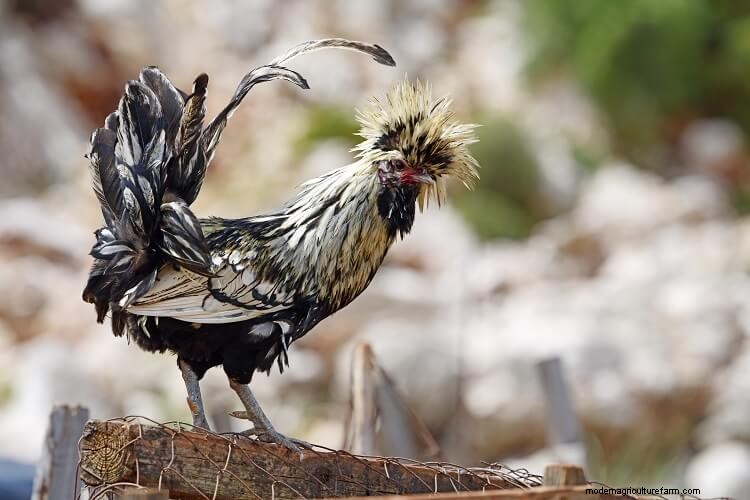
The Houdan is a very old breed that came from France.
They are considered unusual because they have a crest, beard and five toes. Their comb is also unusual as it is a V shape. They were once widely kept as dual purpose hens, but nowadays are more ornamental or exhibition birds.
Do not expect many eggs with this breed as they will only give 2-3 small eggs a week. They are non-setters, but older hens can have a tendency towards broodiness.
Overall this is a docile and sweet chicken that enjoys lap time and is good with kids.
| Houdan |
|---|
| Main Use: Exhibition |
| Yearly Egg Production: 100-170 |
| Egg Color: White |
| Beginner Friendly: Yes |
| Temperament: Docile |
| Noise Level: Quiet |
| Preferred Climate: Any |
The Malay chicken is certainly not for everyone.
This is an unruly chicken prone to picking on other breeds – they will even feather pluck their own if confined.
They are a game bird (hence the crabby temperament) and were widely used back in the 1900s to create or invigorate other breeds.
These days the Malay is considered to be an ornamental or show bird. The hens are poor layers, so if you get one egg a week you will be lucky.
As they originate from Indonesian they are tolerant of heat, not so much the cold though!
| Malay |
|---|
| Main Use: Exhibition |
| Yearly Egg Production: <100 |
| Egg Color: Brown |
| Beginner Friendly: No |
| Temperament: Quarrelsome (Aggressive) |
| Noise Level: Normal |
| Preferred Climate: Warm Climates |
The Old English Game has remained virtually unchanged for 2000 years!
Unfortunately it was introduced to Britain by the Romans for cock fighting. However since cock fighting is now illegal, it is used as a show or exhibition bird.
This breed cannot be kept with other fowl as it will fight them – even the hens will fight.
Roosters should be separated out at six months or they will fight to the death.
Surprisingly though, they can be friendly and talkative with their humans.
| Old English Game |
|---|
| Main Use: Exhibition |
| Yearly Egg Production: 100-170 |
| Egg Color: Cream |
| Beginner Friendly: No |
| Temperament: Quarrelsome (Aggressive) |
| Noise Level: Loud |
| Preferred Climate: Any |
This breed is for those who have the time, energy and devotion to care for them.
The Onagadori is an ancient breed from Japan where it enjoys a special historical status.
They are friendly, calm, docile and are primarily used for shows.
Onagadori literally means long tail in Japanese, and they are kept for these tails. The longest tail ever recorded was a stunning 88 feet.
These chickens need special accommodations and care and should be kept by themselves to prevent damage to their tails.
| Onagadori |
|---|
| Main Use: Exhibition |
| Yearly Egg Production: 100-170 |
| Egg Color: White |
| Beginner Friendly: No |
| Temperament: Docile |
| Noise Level: Quiet |
| Preferred Climate: Warm Climates |
The Phoenix is a German creation that came into being around the 1800s.
They are a cross between several Japanese long tailed breeds and several German breeds.
Interestingly the Phoenix molts their tail each year.
It is a beautiful breed with a good personality – they are alert, docile, gentle and talkative. They are known to be friendly and can become good pets.
Today they are mainly used as show breeds and there are several color varieties to choose from.
| Phoenix |
|---|
| Main Use: Exhibition |
| Yearly Egg Production: <100 |
| Egg Color: Cream |
| Beginner Friendly: No |
| Temperament: Friendly |
| Noise Level: Normal |
| Preferred Climate: Any |
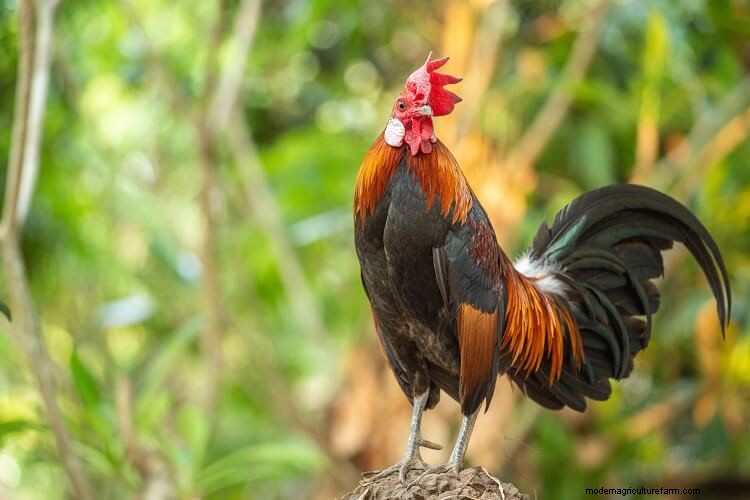
Meet the breed that started it all.
The Red Jungle fowl is an ancestor of pretty much every chicken we see today.
They were captured and semi-domesticated around 8000 years ago by humans. They still roam freely in areas of the Far East from Thailand down to the Indonesian islands. To this day they remain wary of humans and avoid contact if possible.
This breed does not like being handled and if allowed to free range will wander far and wide.
The Jungle fowl is a smallish chicken with hens reaching only 2¼lb.
| Red Jungle Fowl |
|---|
| Main Use: Exhibition |
| Yearly Egg Production: <100 |
| Egg Color: White |
| Beginner Friendly: No |
| Temperament: Bold (Self Assured) |
| Noise Level: Normal |
| Preferred Climate: Warm Climates |
The Shamo is an Asian breed and was originally raised as a fighting bird. They are a tall chicken with muscular thighs and body, a small pea comb and very small or non-existent wattles.
This chicken is actually a strain of the Asian Asil (Aseel). There are four varieties of Shamo with the heaviest rooster weighing around 12lb.
A chicken like this requires special handling and accommodations.
Even the hens can be aggressive with other breeds and roosters will fight and kill other chickens. This aggressive trait can also be problematic with the chicks – they may fight and kill each other.
Hens are poor layers giving you perhaps 2 light brown medium sized eggs per week.
These birds are not for novices and definitely not children.
| Shamo |
|---|
| Main Use: Exhibition |
| Yearly Egg Production: <100 |
| Egg Color: Brown |
| Beginner Friendly: No |
| Temperament: Quarrelsome (Aggressive) |
| Noise Level: Normal |
| Preferred Climate: Warm Climates |
The Sultan is the ultimate in show chickens .
This chicken has it all:V comb, crest, beard and muffs, vulture hocks, feathered feet, a long tail and five toes.
Originally they are from Turkey where they were known as the Serai Taook or Sultans fowl. They were allowed to roam the grounds of the palace because they did not scratch up the dirt or grass.
They are a calm, docile and very friendly hen well suited to pet status. They like to be active but should be either confined or supervised whilst free ranging.
Unfortunately they are critically endangered according to the Livestock Conservancy.
| Sultan |
|---|
| Main Use: Exhibition |
| Yearly Egg Production: <100 |
| Egg Color: White |
| Beginner Friendly: No |
| Temperament: Docile |
| Noise Level: Quiet |
| Preferred Climate: Warm Climates |
The Sumatra was originally imported from Indonesia where it can still be found today.
They were originally used as a fighting bird and although the males can be aggressive during the mating season, it is rare to find them fighting to the death. Out of mating season they are relatively calm.
This is not a breed that tolerates confinement. They are active, restless and fly well. They can be easily handled by their humans.
The hens weigh around 4lb and are variable layers (strain dependant).
Their main use today is as an ornamental breed and they can be found in bantam size also.
| Sumatra |
|---|
| Main Use: Exhibition |
| Yearly Egg Production: <100 |
| Egg Color: White |
| Beginner Friendly: No |
| Temperament: Skittish |
| Noise Level: Normal |
| Preferred Climate: Any |
The Thuringian comes from the Thuringian Forest area of Germany and has been documented since the mid-1700s.
This is a rare chicken although their popularity seems to be increasing.
They are considered to be a dual purpose breed but now they are mainly kept for eggs and exhibition. Hens will lay 3 white eggs each week and rarely go broody – if they do, they make good mothers.
There are several color varieties to choose from and they are all bearded with muffs.
Overall this is a confident, active, talkative and very friendly chicken that would be ideal for children.
| Thuringian |
|---|
| Main Use: Exhibition |
| Yearly Egg Production: 100-170 |
| Egg Color: White |
| Beginner Friendly: No |
| Temperament: Bold (Self Assured) |
| Noise Level: Normal |
| Preferred Climate: Any |
This ancient breed can be traced back about 1500 years!
The breed we see today was developed in Japan and is considered an historical artifact in Japan.
They belong to the long crowing family and roosters can hold their crow for up to 25 seconds.
Boys also have long tails that can grow up to 4 feet, so special accommodations are required for this breed.
Hens are poor layers producing 2 white eggs each week.
Personality wise they are known for being gentle and talkative. Their plumage is all black with a green sheen in the light.
Tomarus are kept mainly for exhibition in the west, but in the Far East there are crowing contests for which these chickens are kept.
| Tomaru |
|---|
| Main Use: Exhibition |
| Yearly Egg Production: <100 |
| Egg Color: White |
| Beginner Friendly: No |
| Temperament: Docile |
| Noise Level: Loud |
| Preferred Climate: Warm Climates |
The White Faced Black Spanish, also known as Cara Blanca, hails from Spain and is an old breed possibly dating back to the 1500s.
Sadly these days she is critically endangered.
This breed is mainly kept for eggs and ornamental purposes. They certainly stand out from the crowd with their white clown faces . The hens are decent layers, producing 3 large white eggs a week.
They are independent and do not like to be picked up or held. You can expect a noisy flighty chicken that likes to free range and forage.
This breed is rather slow to mature and can take a year to reach adulthood.
White Faced Black Spanish are available in standard or bantam size.
| White Faced Black Spanish |
|---|
| Main Use: Exhibition |
| Yearly Egg Production: 100-170 |
| Egg Color: White |
| Beginner Friendly: No |
| Temperament: Skittish |
| Noise Level: Loud |
| Preferred Climate: Warm Climates |
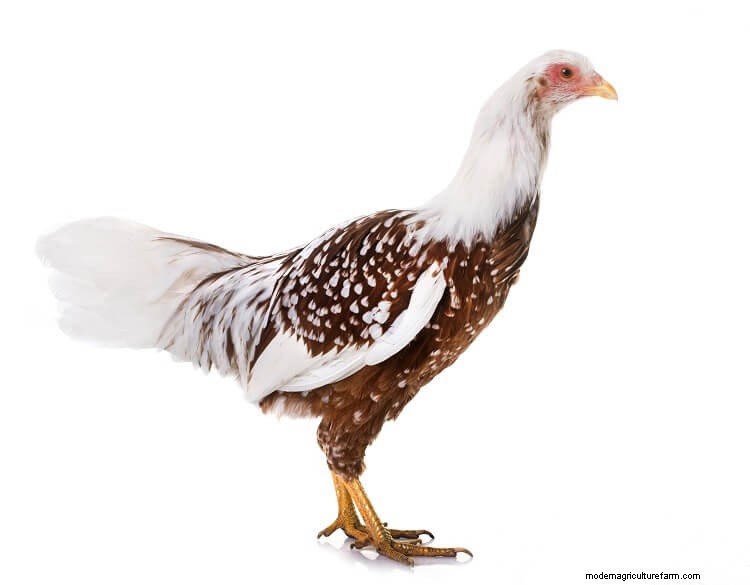
Despite the name, the Yokohama was created in Germany from Japanese parents back in the 1880s. Today it is critically endangered and in need of support.
It is bred for exhibition, show and ornamental uses only.
This is a small breed that is bred for their incredibly long tails (they can grow up to 3 feet each year).
They love to free range as they are an active bird that is always alert for danger.
Overall they are a low maintenance bird that is easy to handle and can become docile and friendly in time.
| Yokohama |
|---|
| Main Use: Exhibition |
| Yearly Egg Production: <100 |
| Egg Color: Cream |
| Beginner Friendly: Yes |
| Temperament: Docile |
| Noise Level: Quiet |
| Preferred Climate: Any |
Chickens are one of the easiest livestock animals to care for and fit well into a small space if need be.
We hope you have enjoyed looking through our chicken breed list.
Hopefully it has helped you to decide what you want in your coop.
Our aim was to let you know what is available and what sort of chickens there are so that you do not end up with a hen that is of no practical use to you.
Did we miss your favorite breed? Let us know in the comments section below…